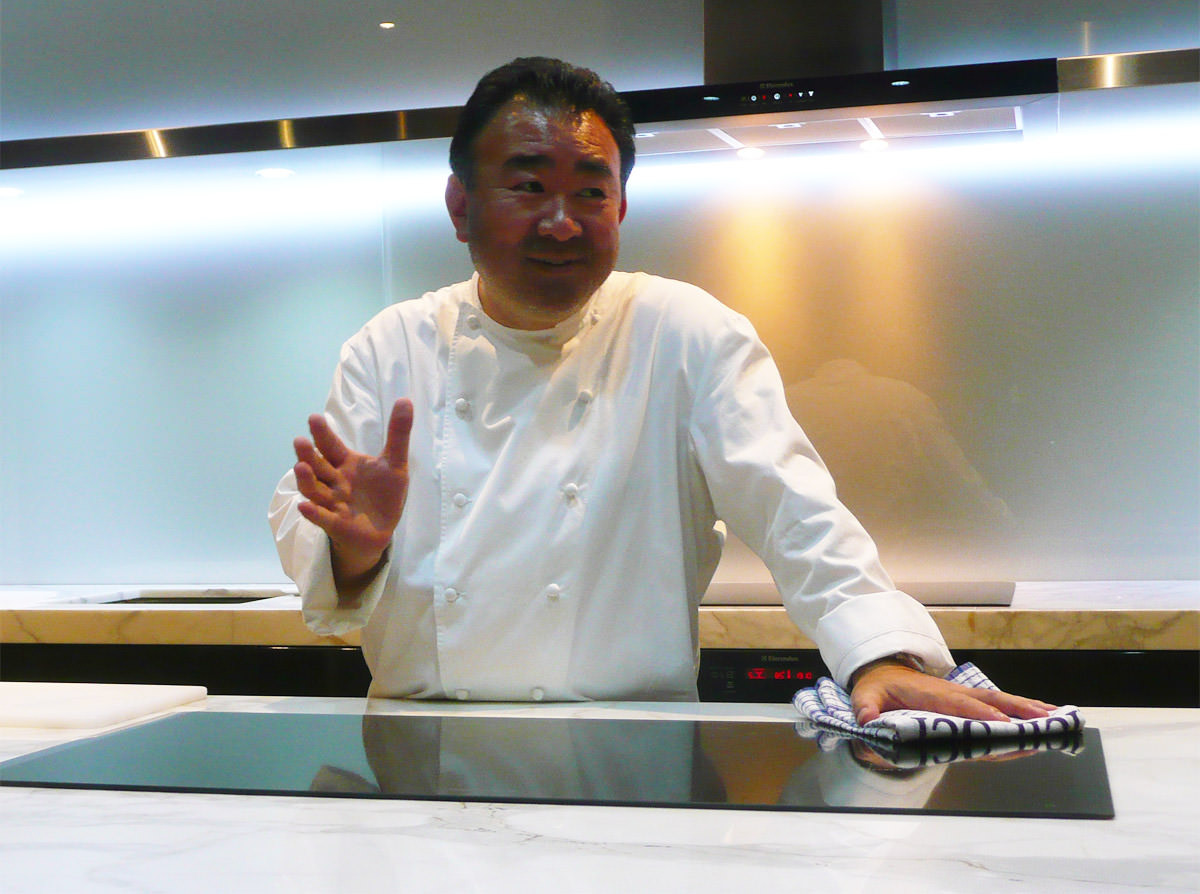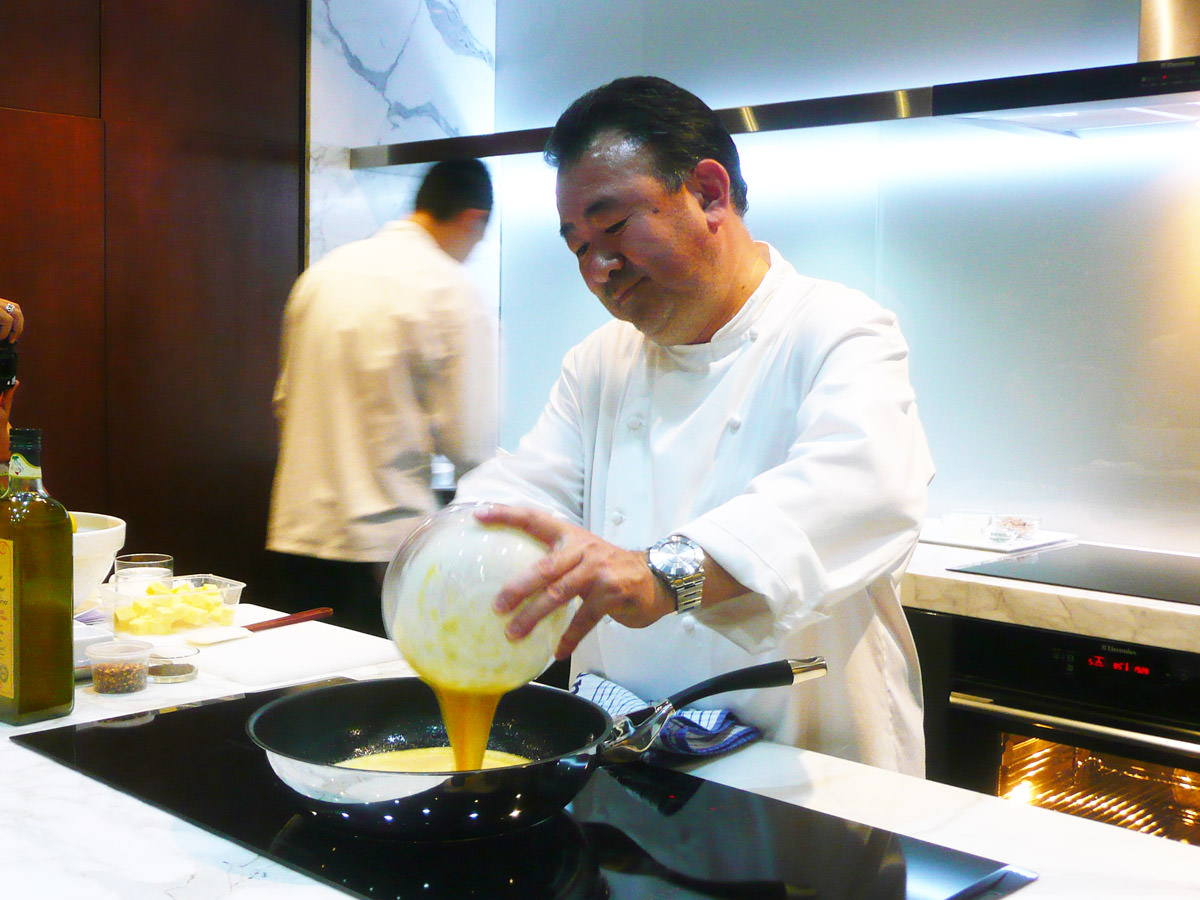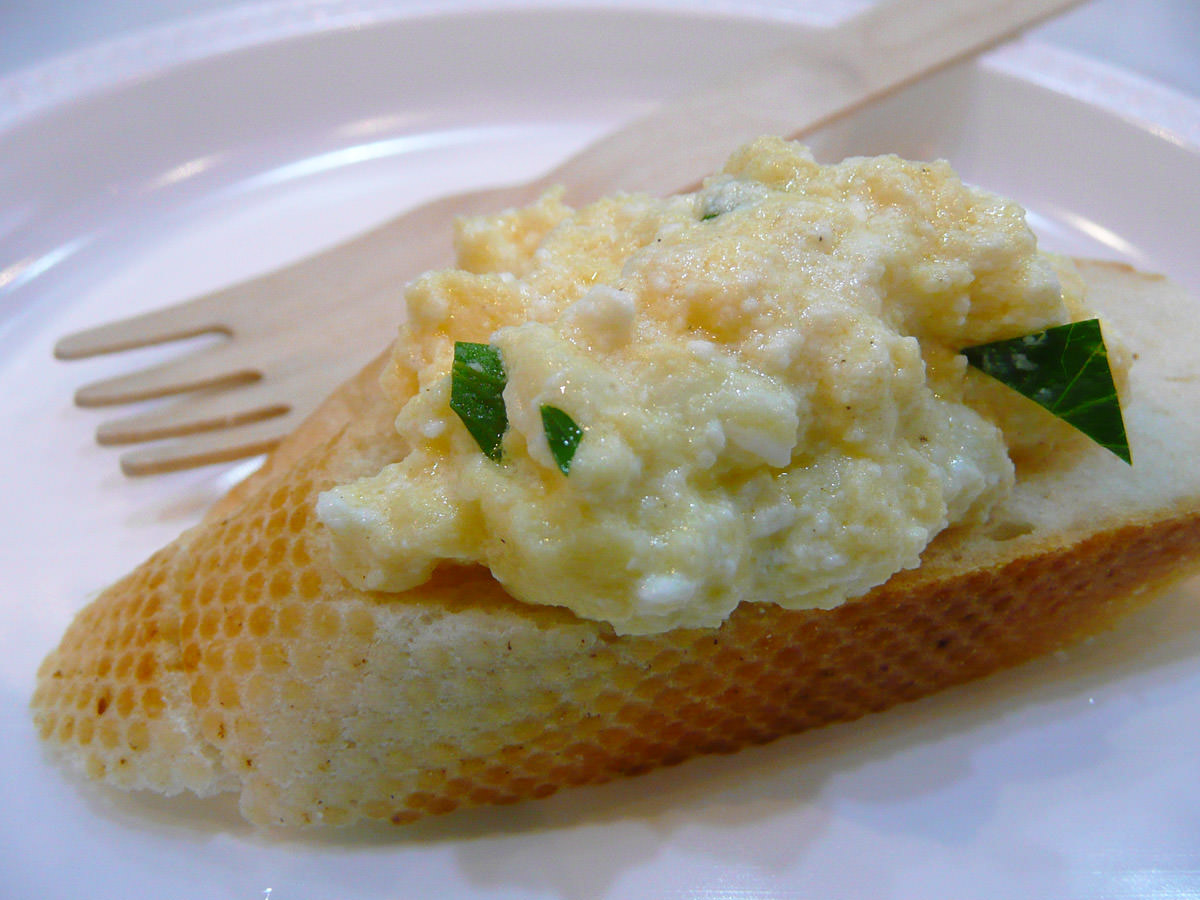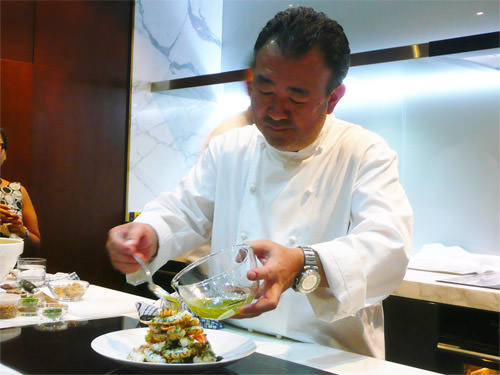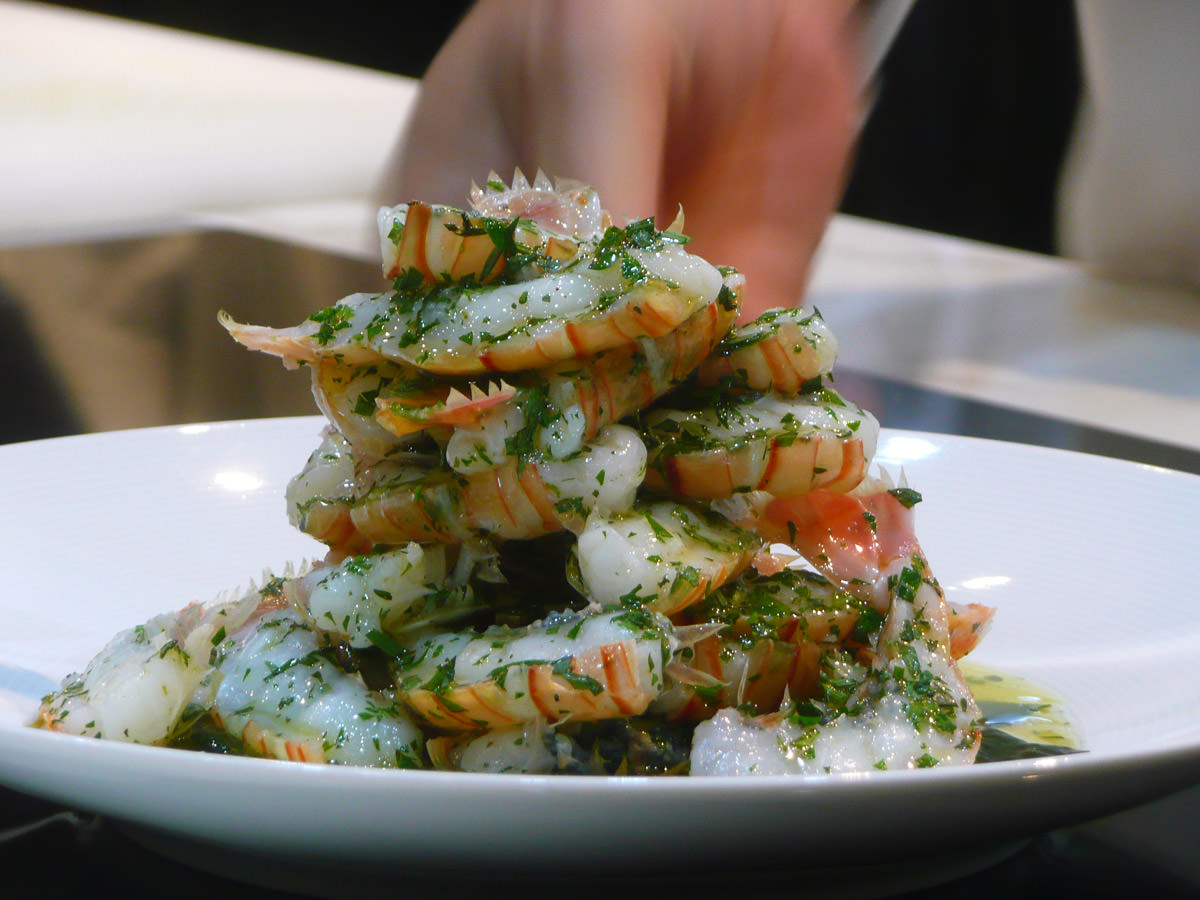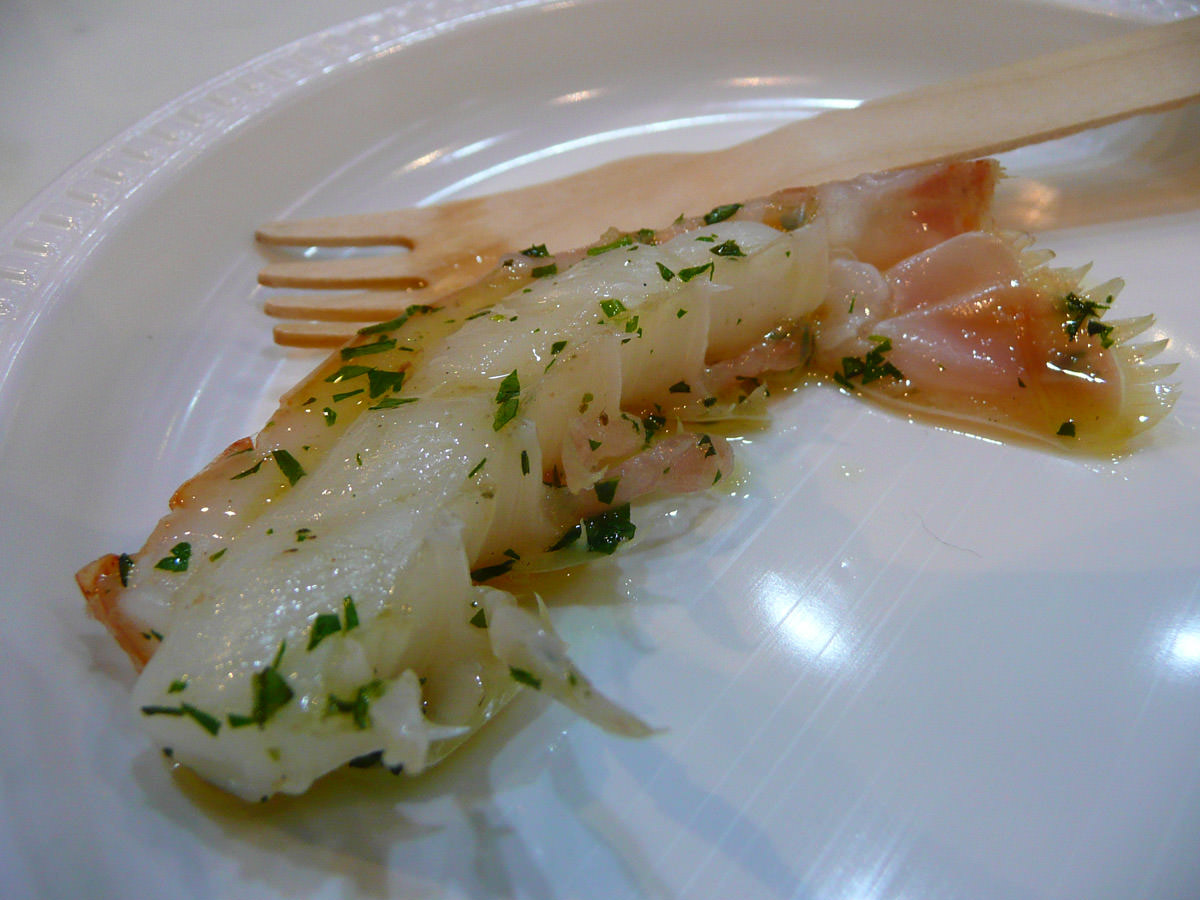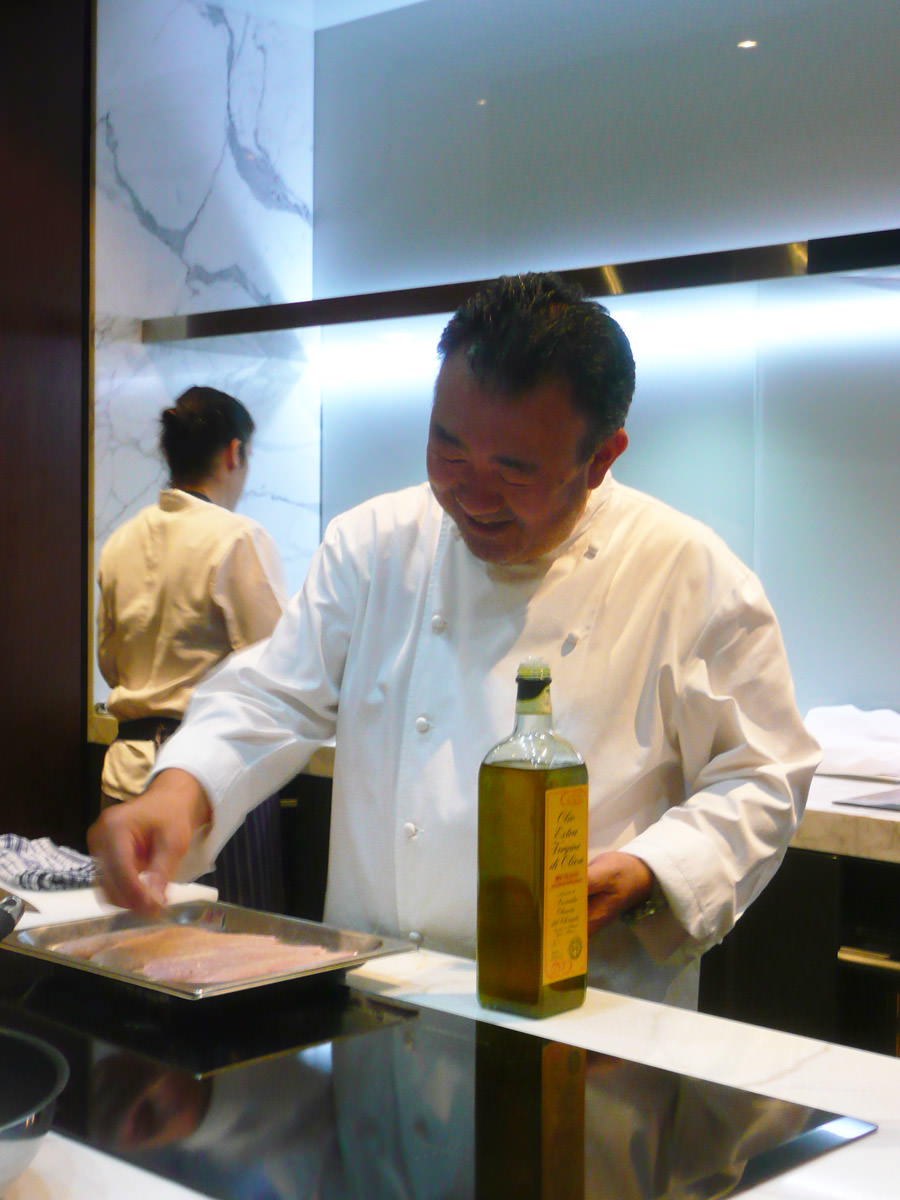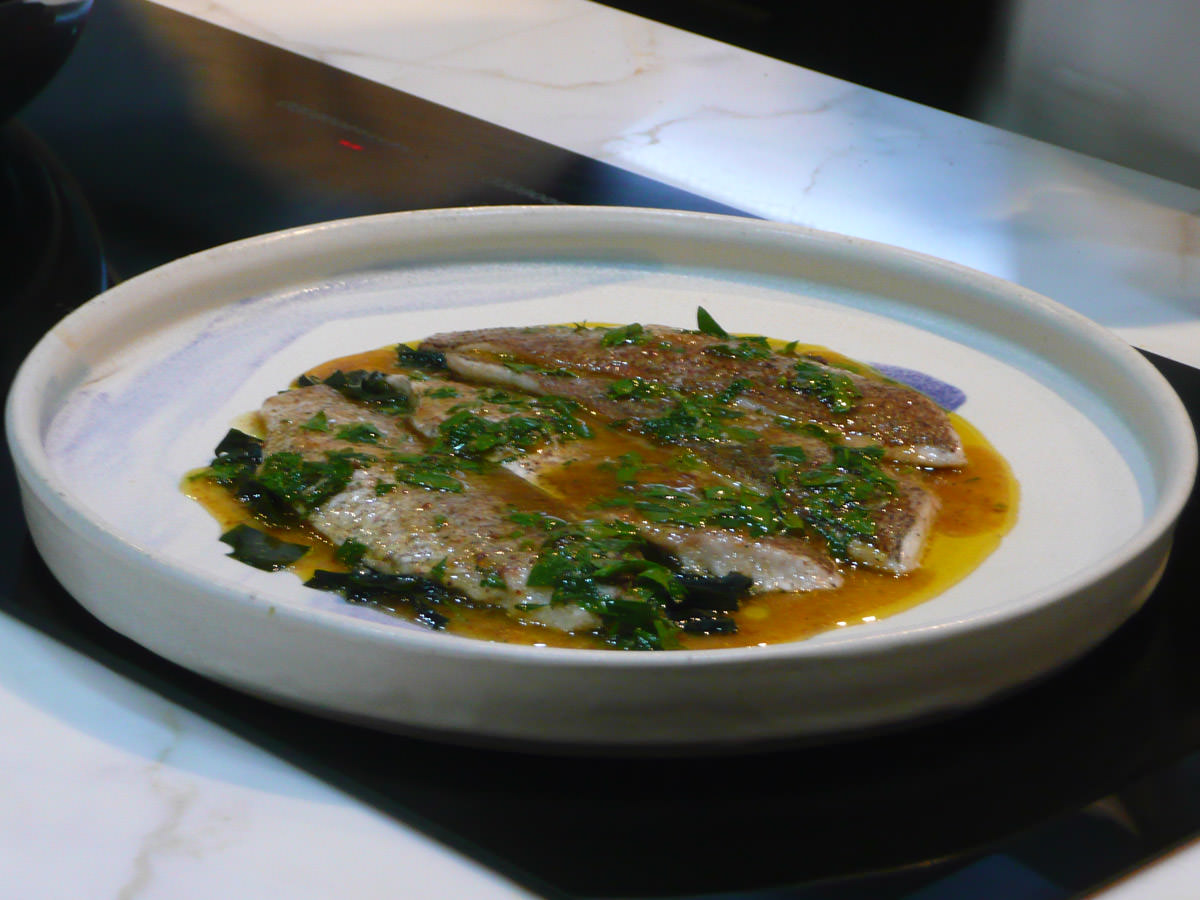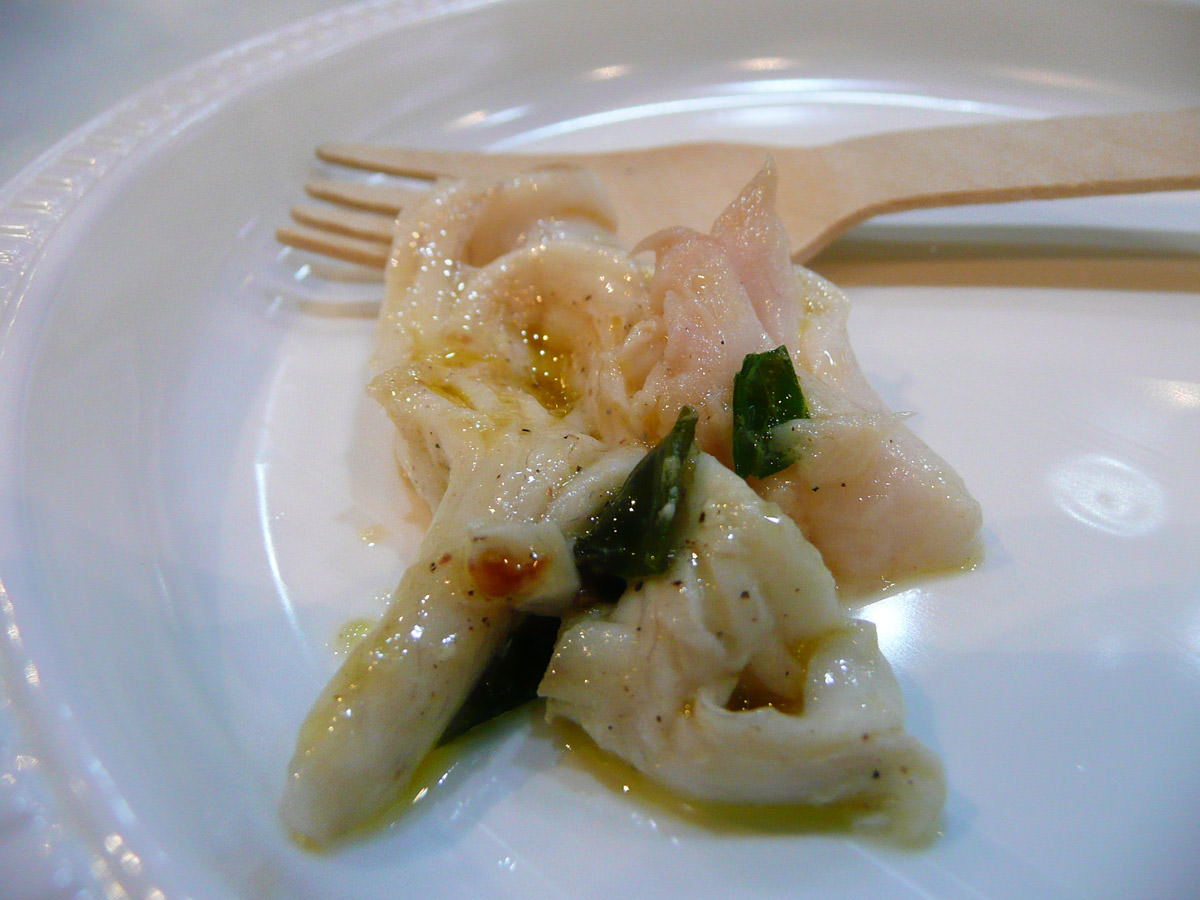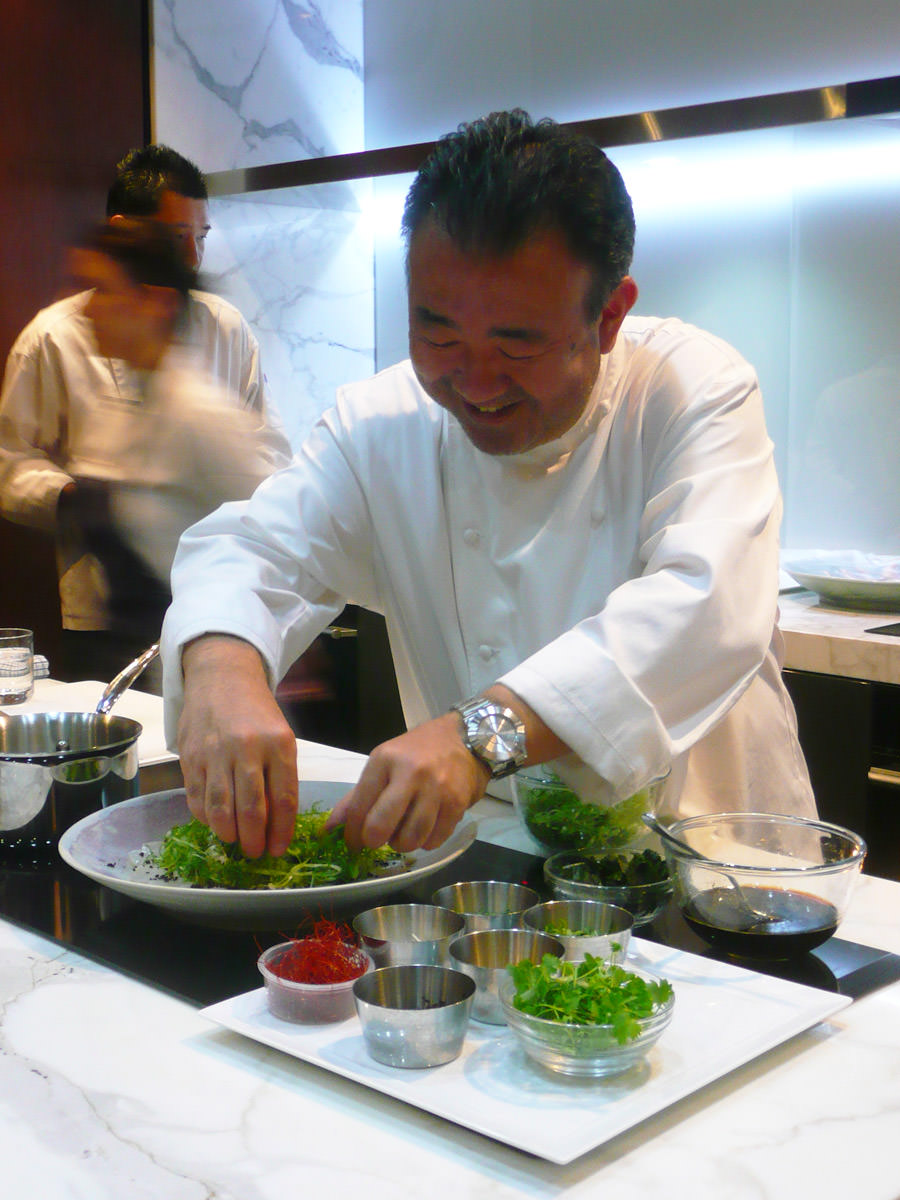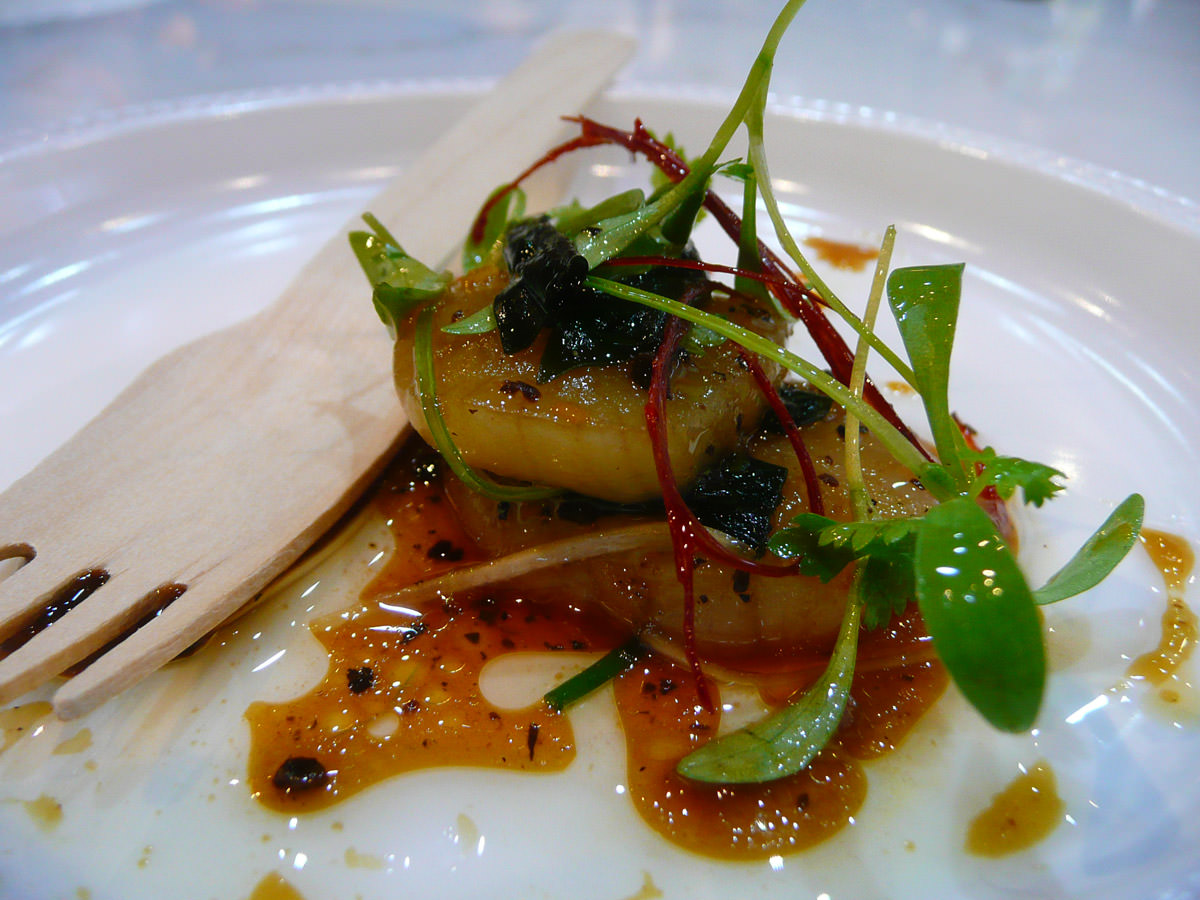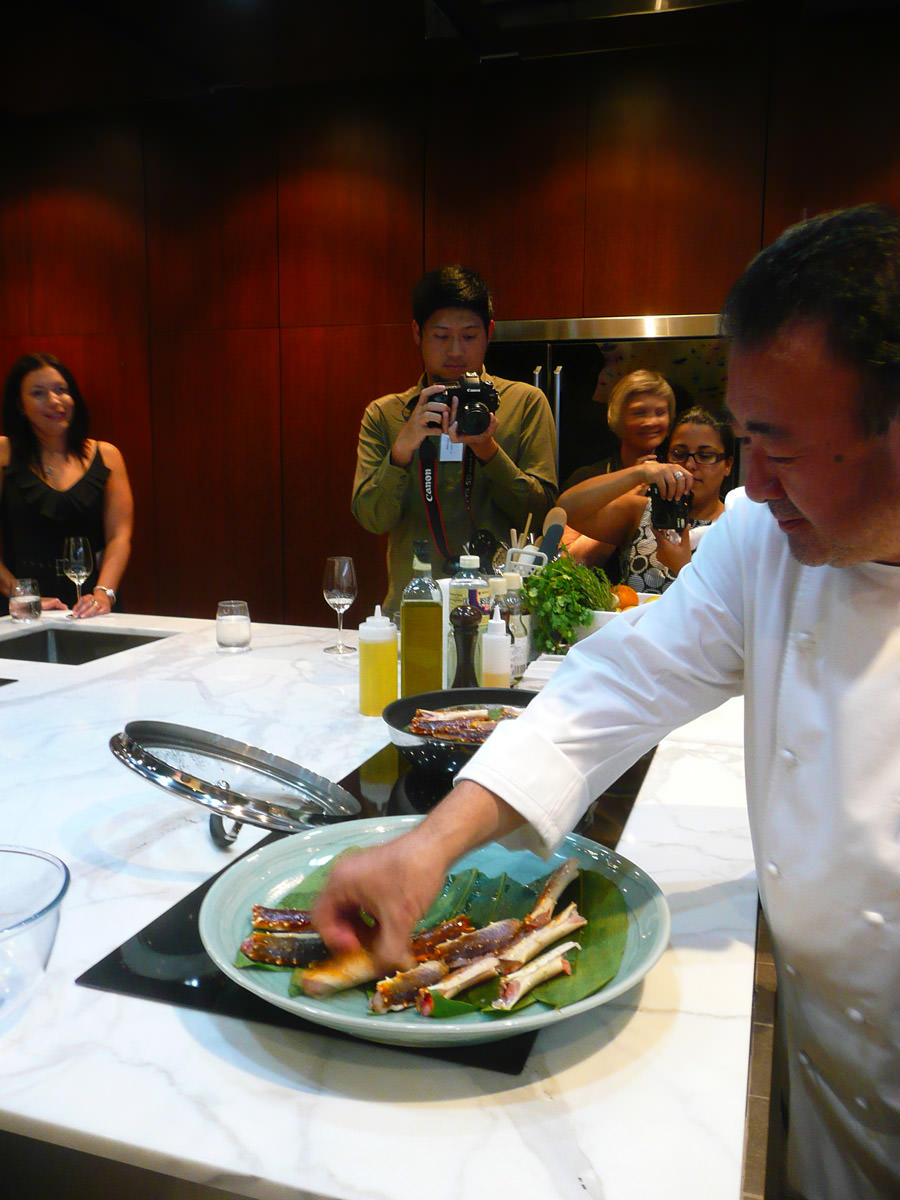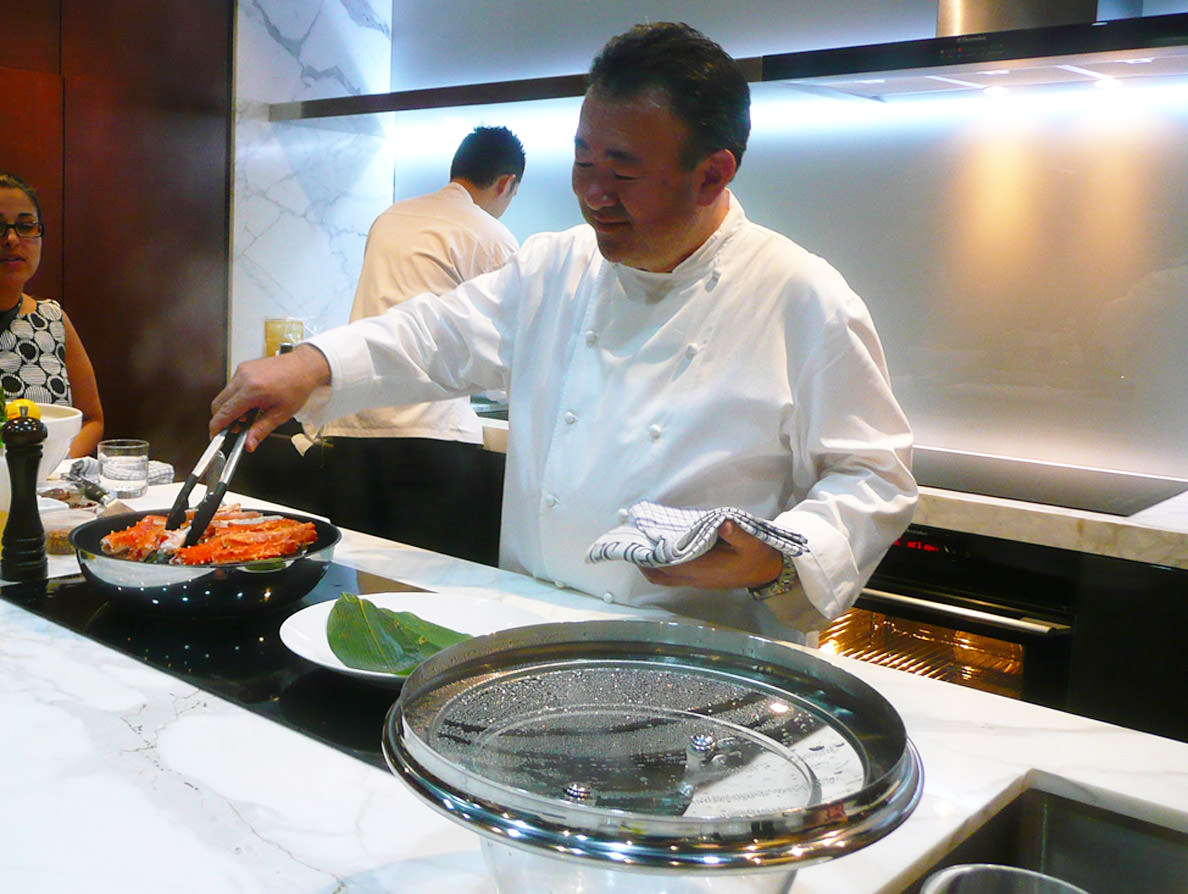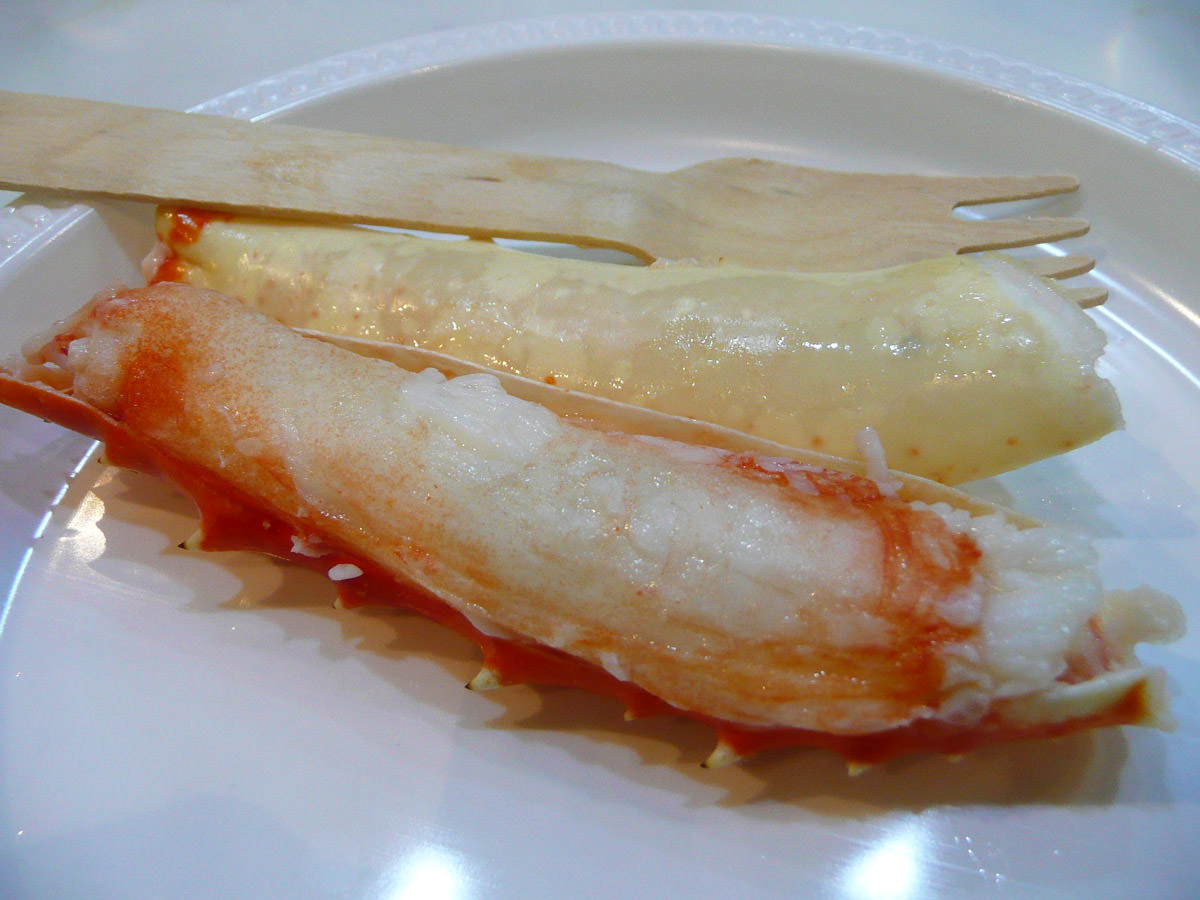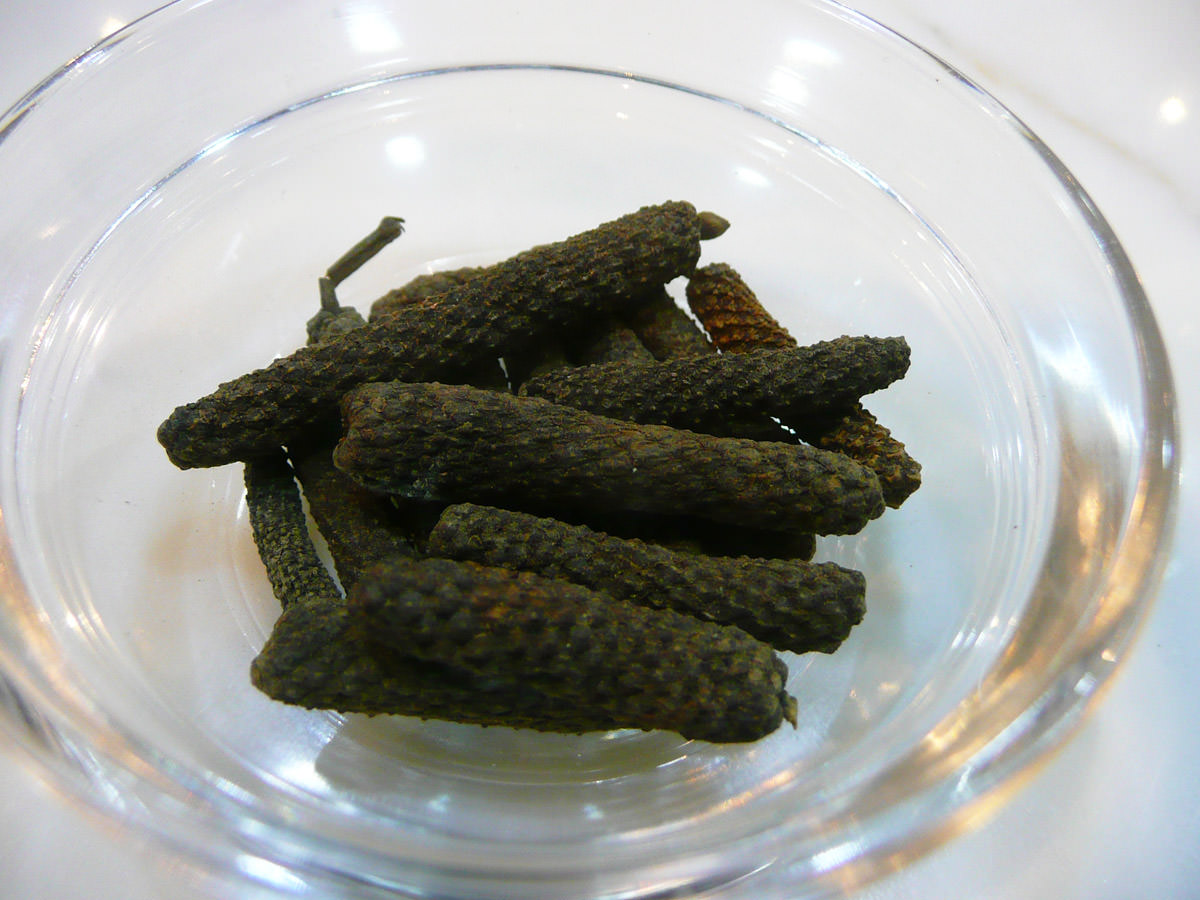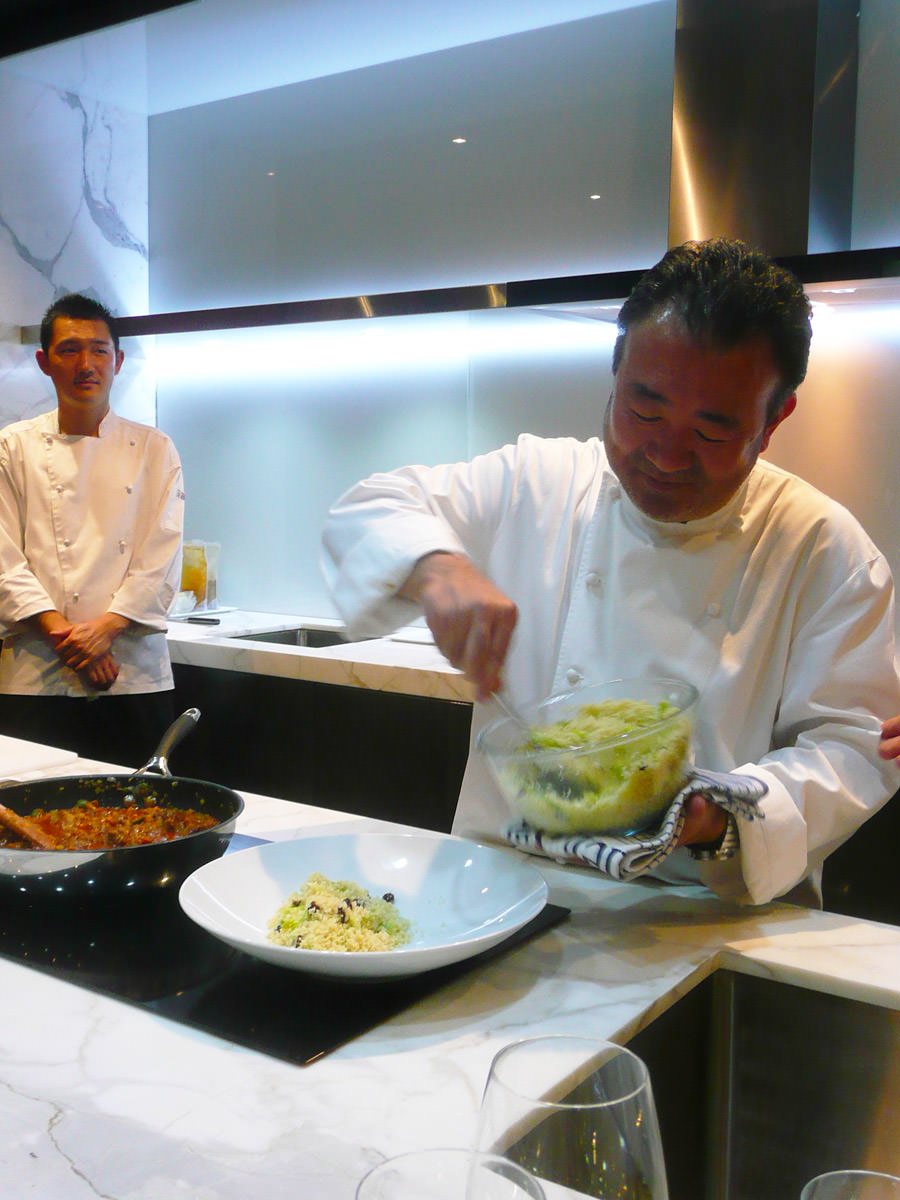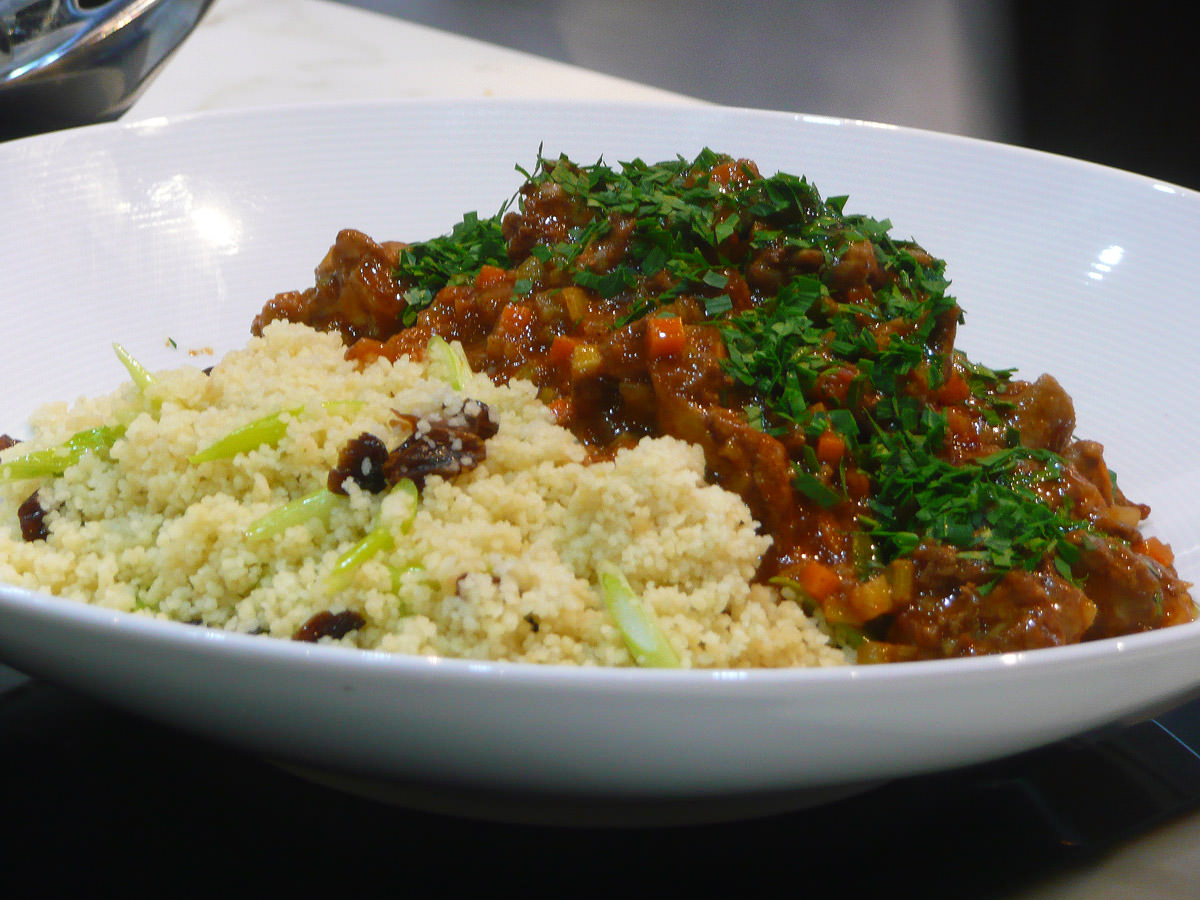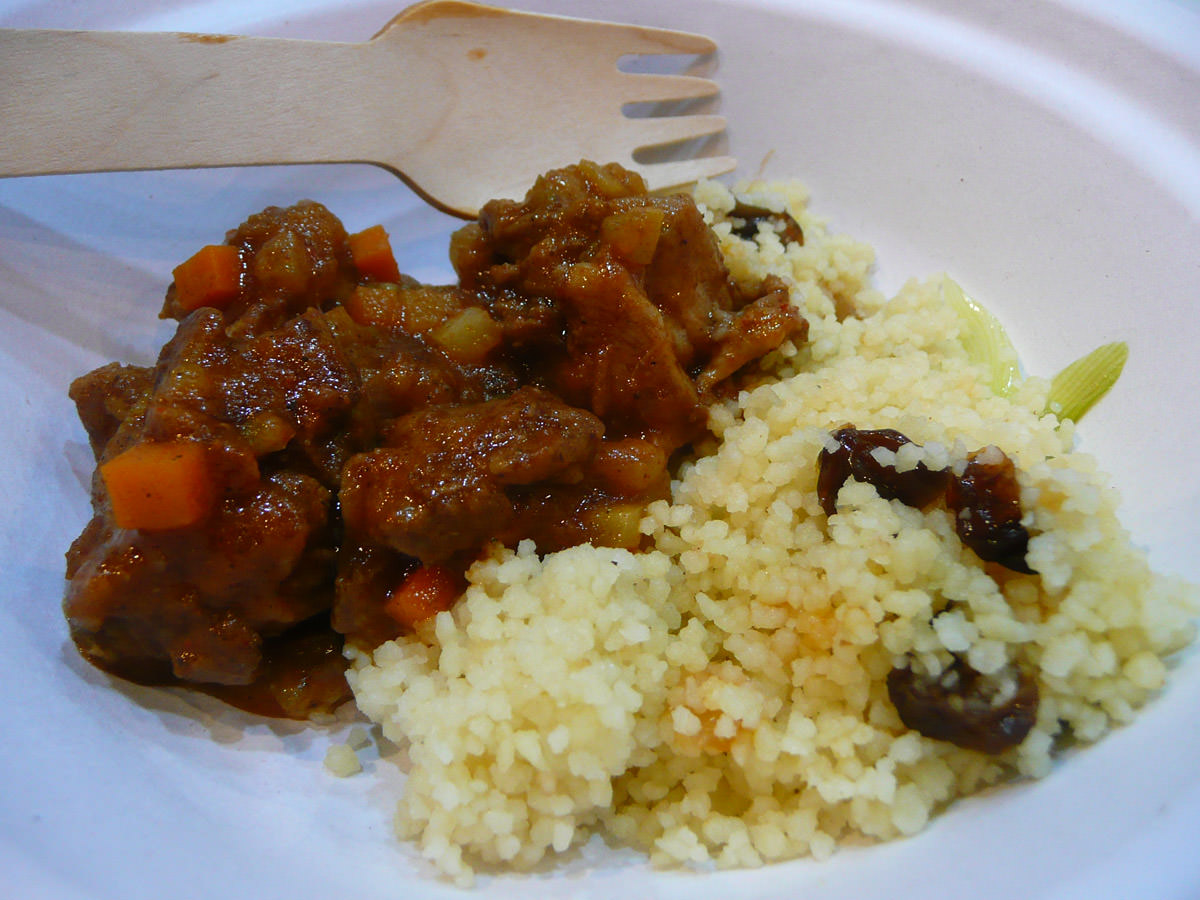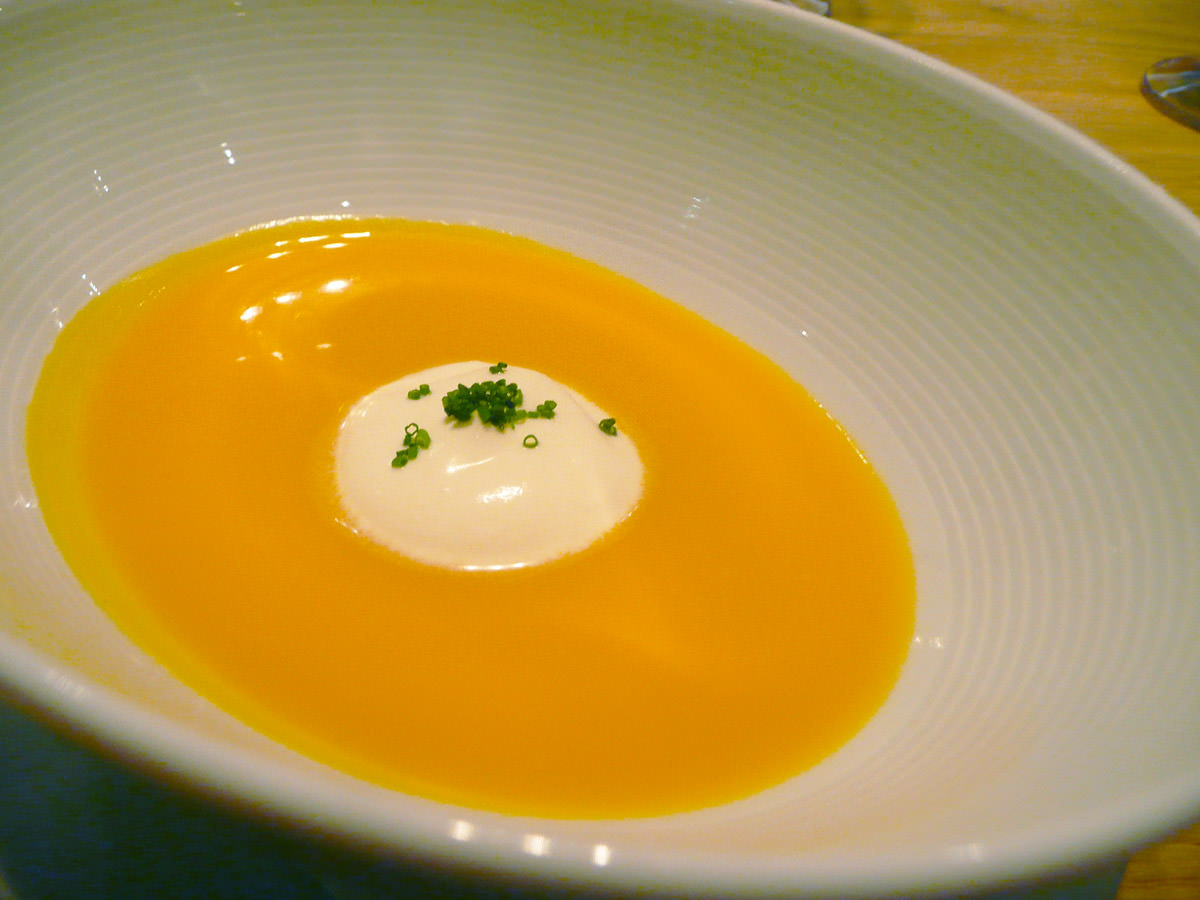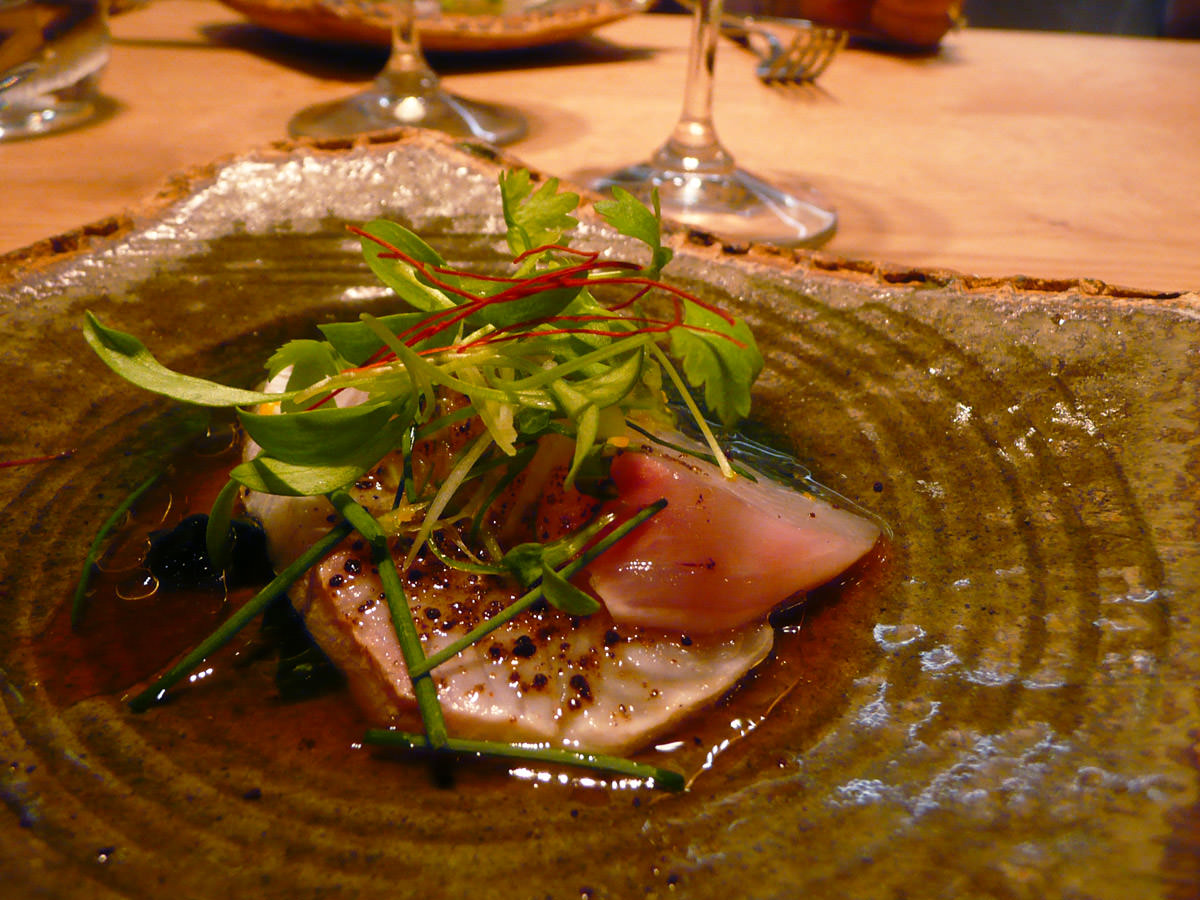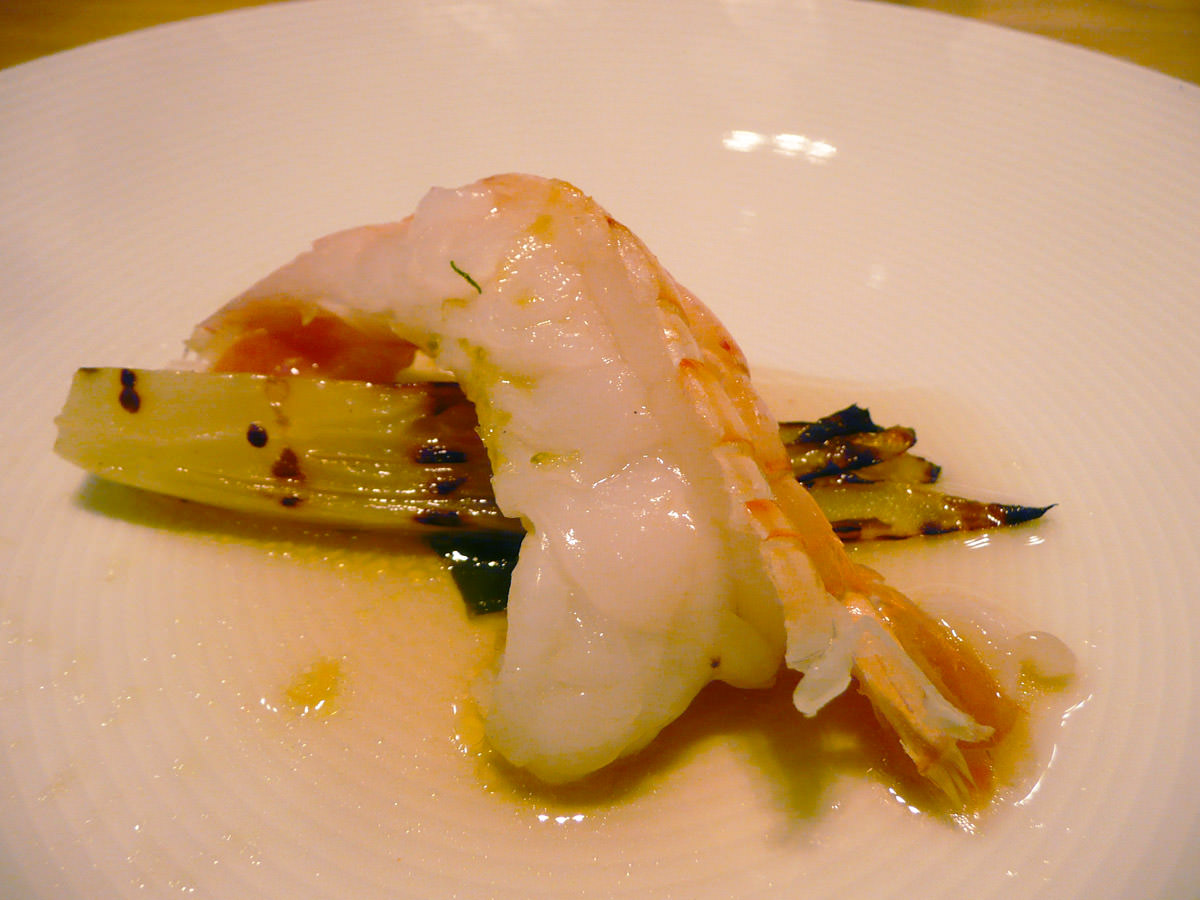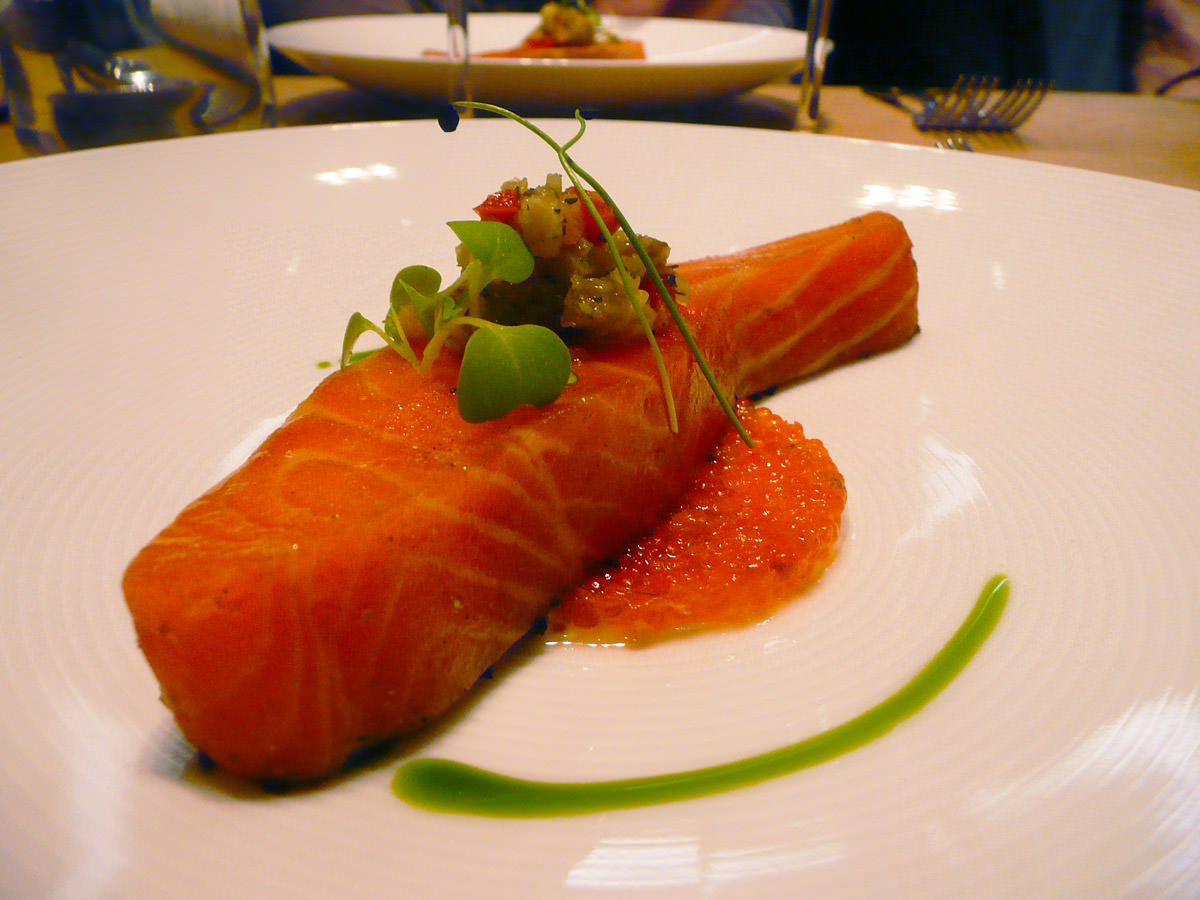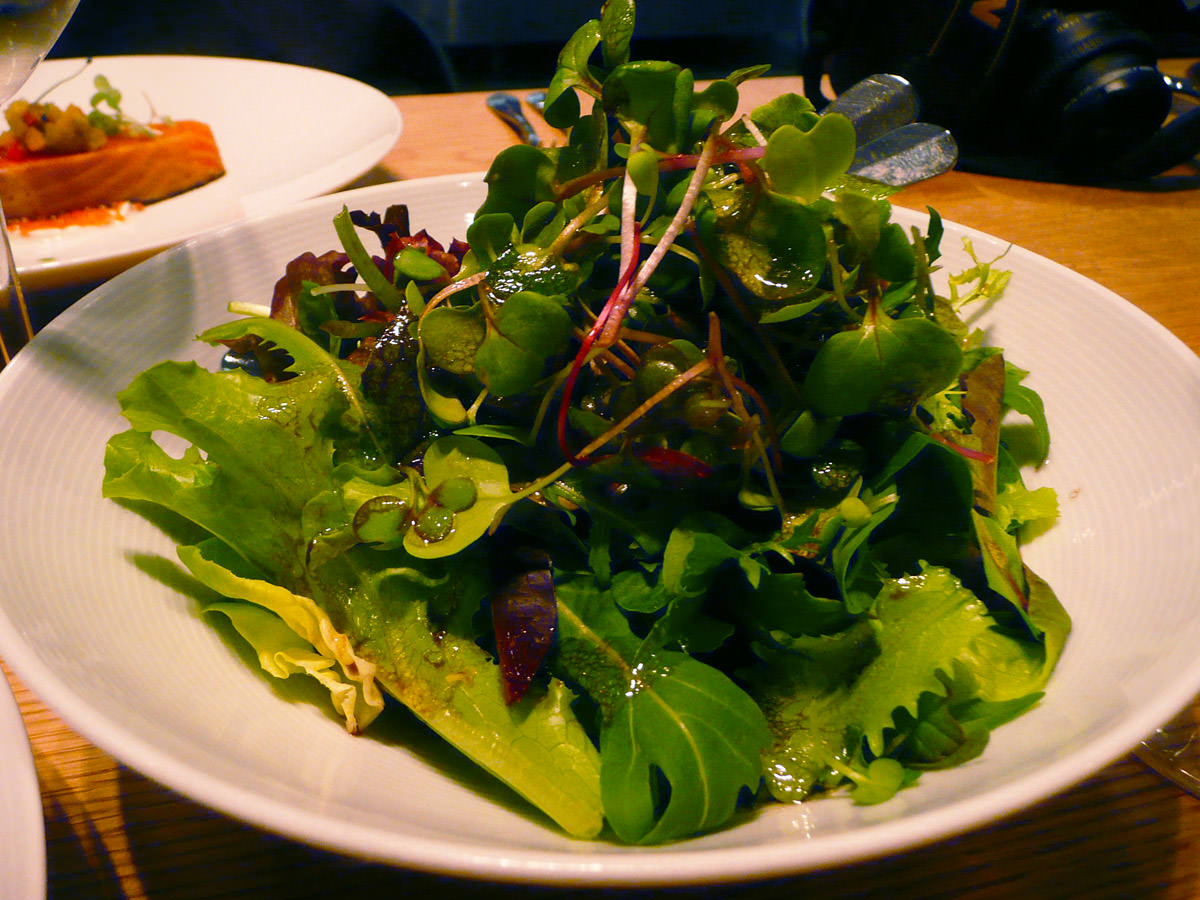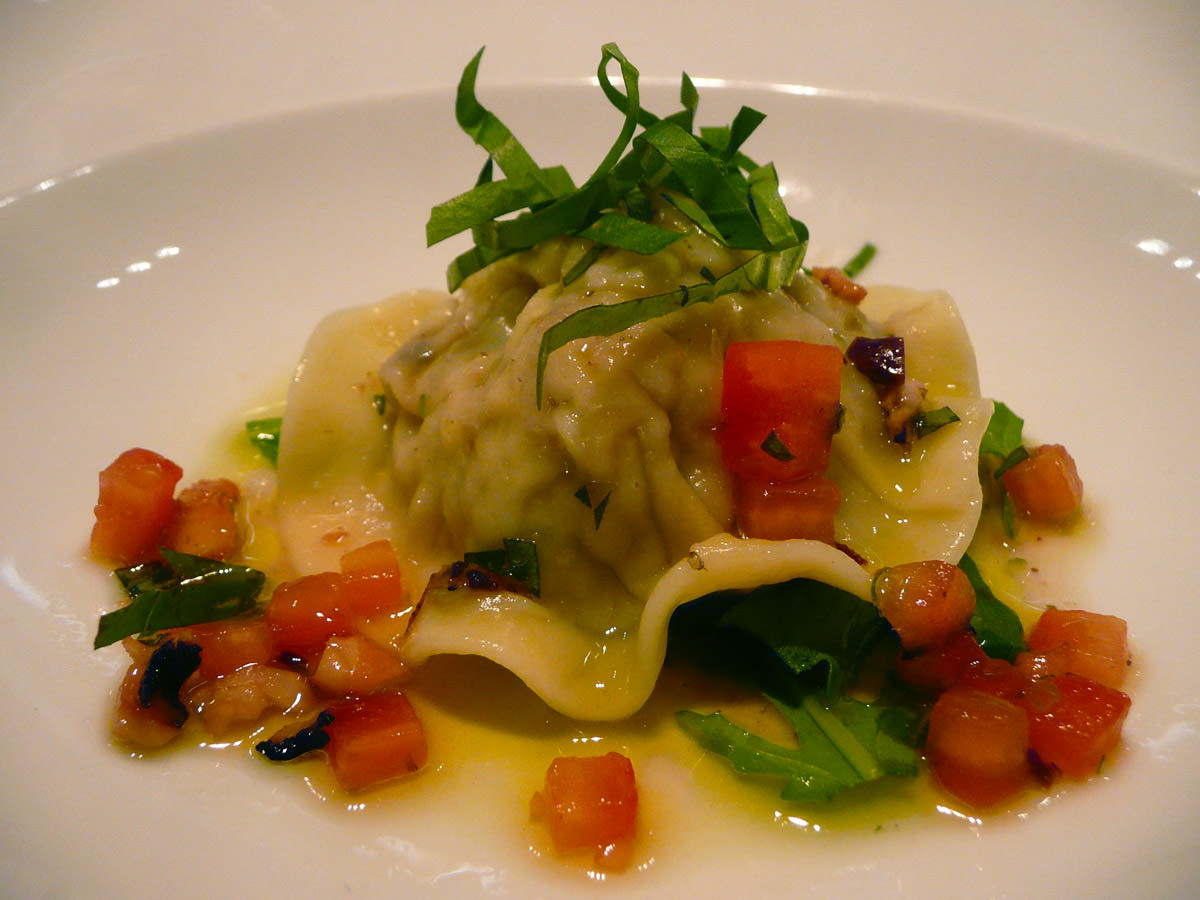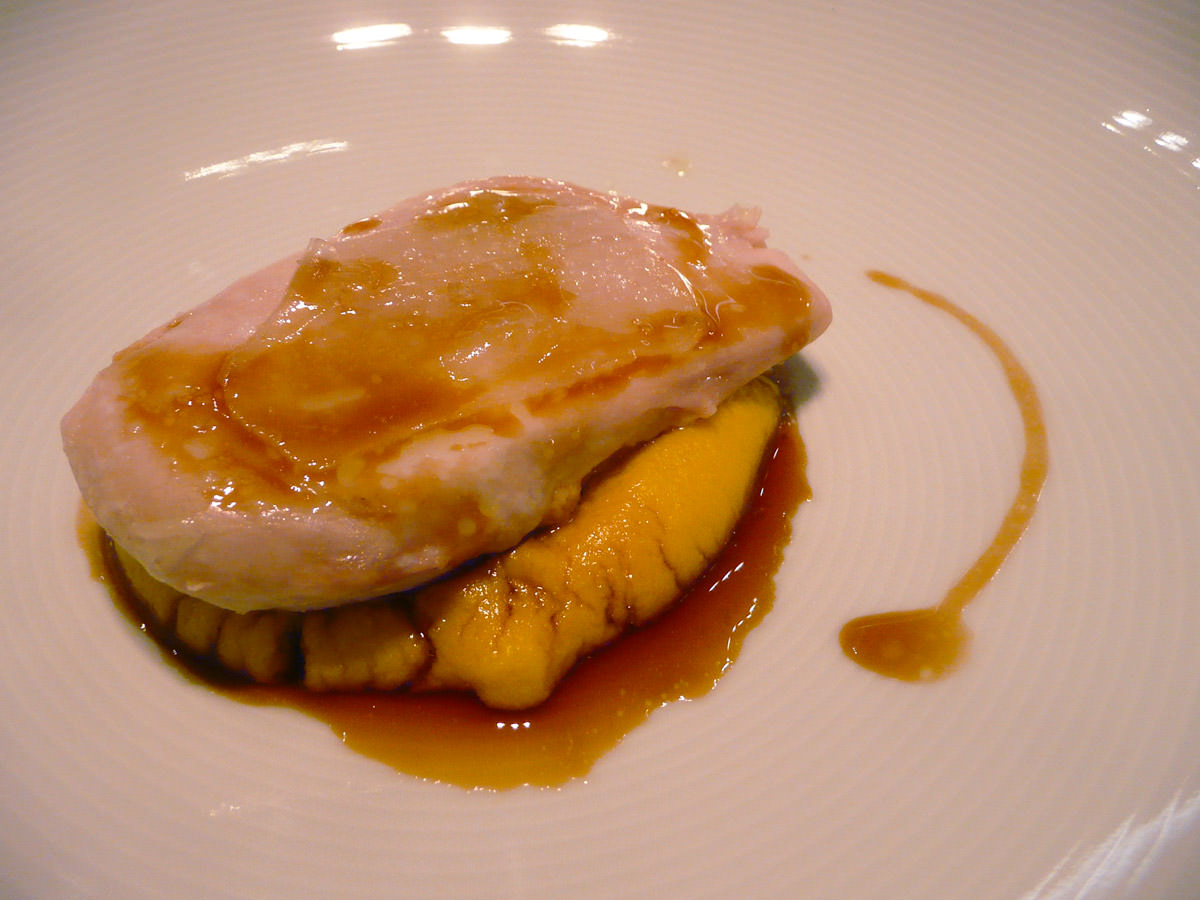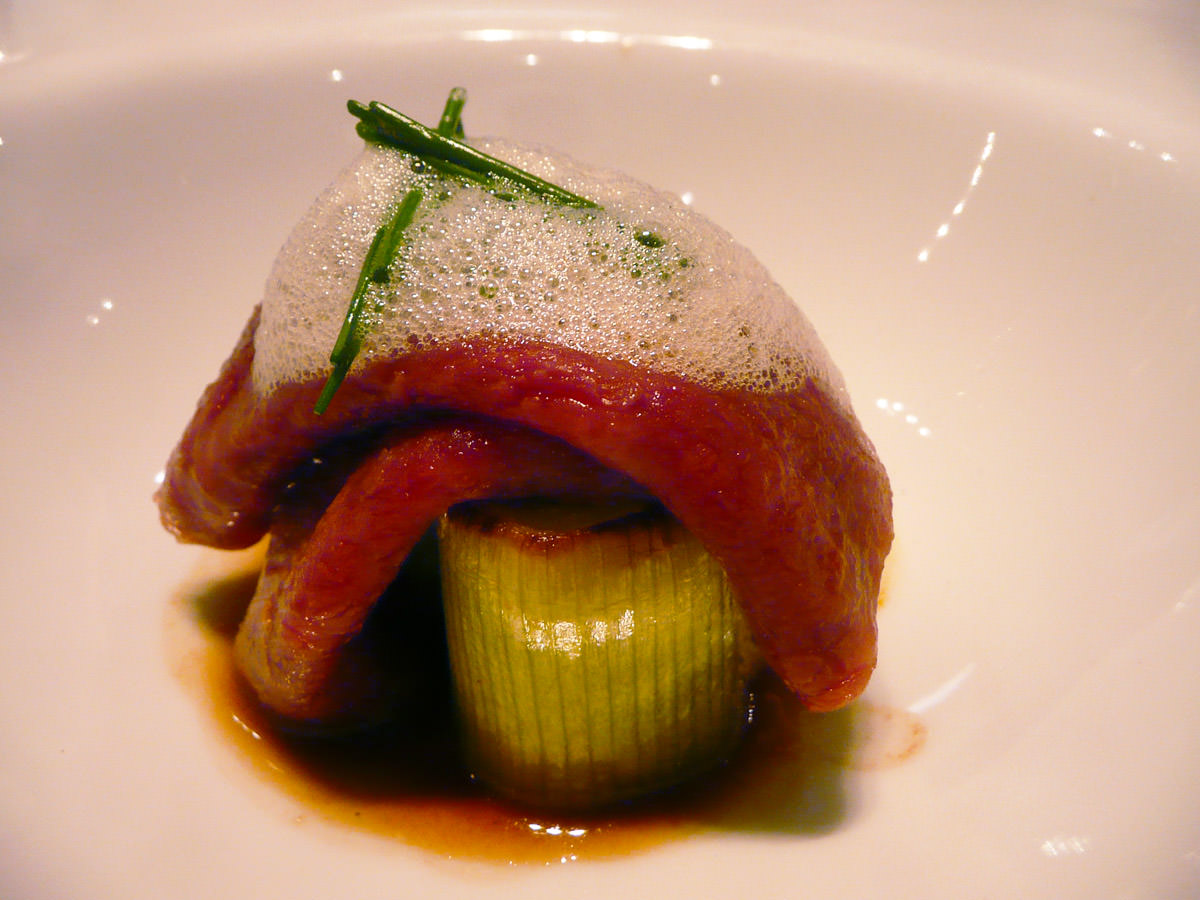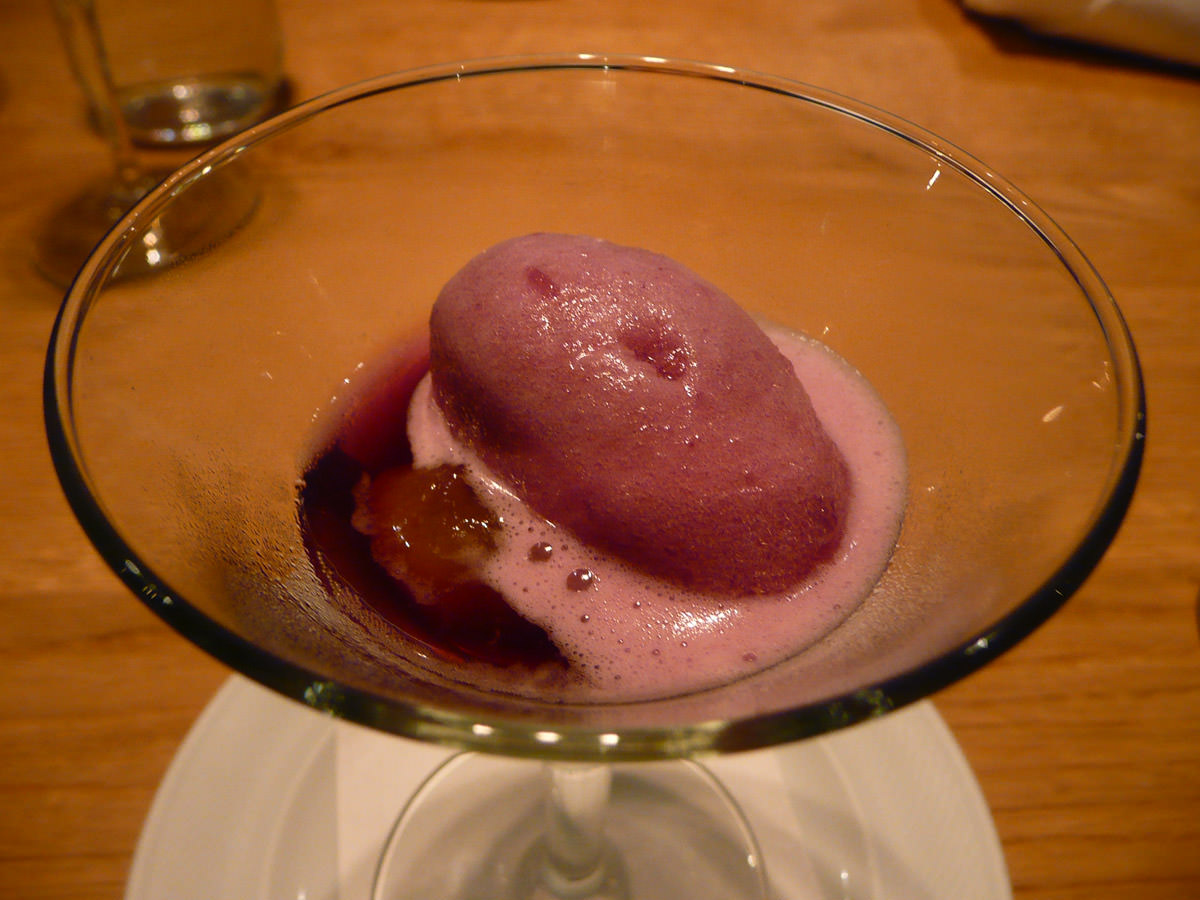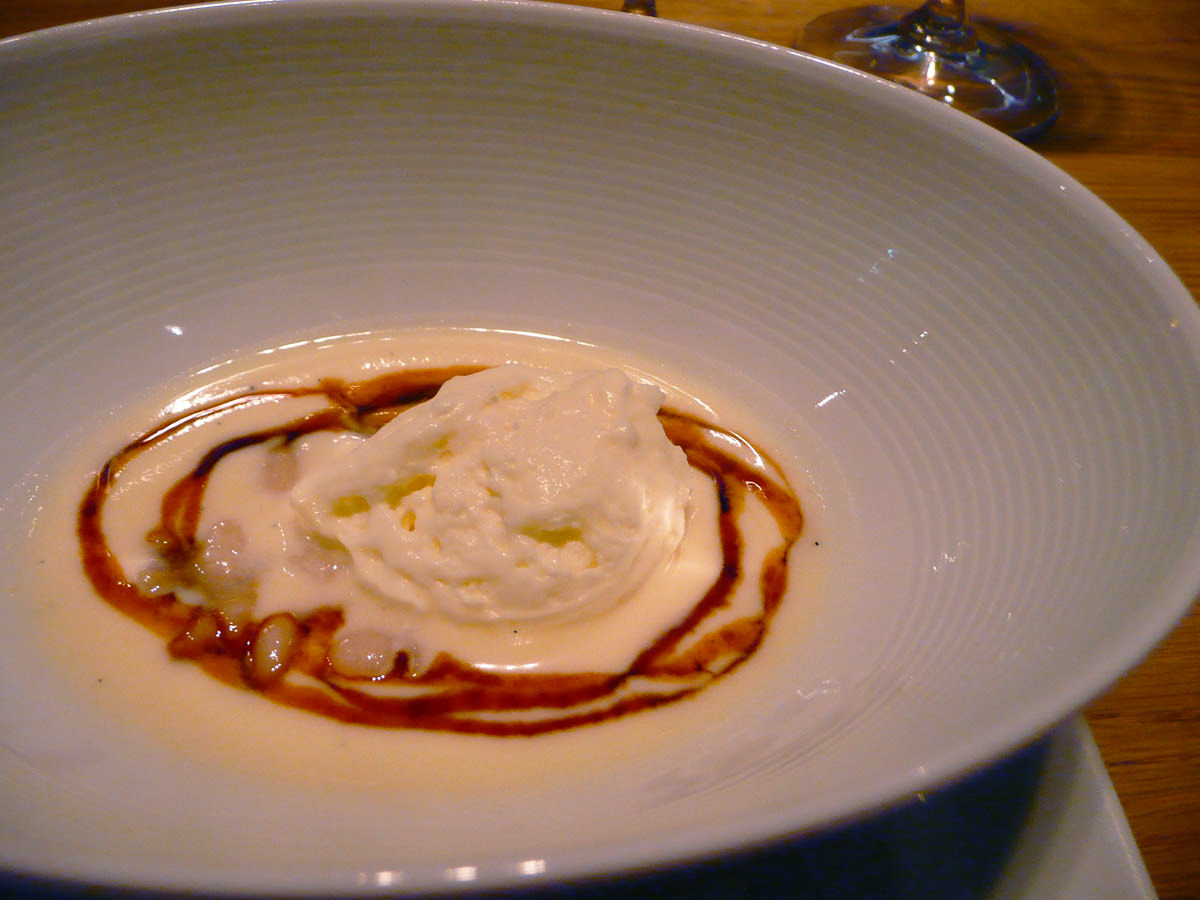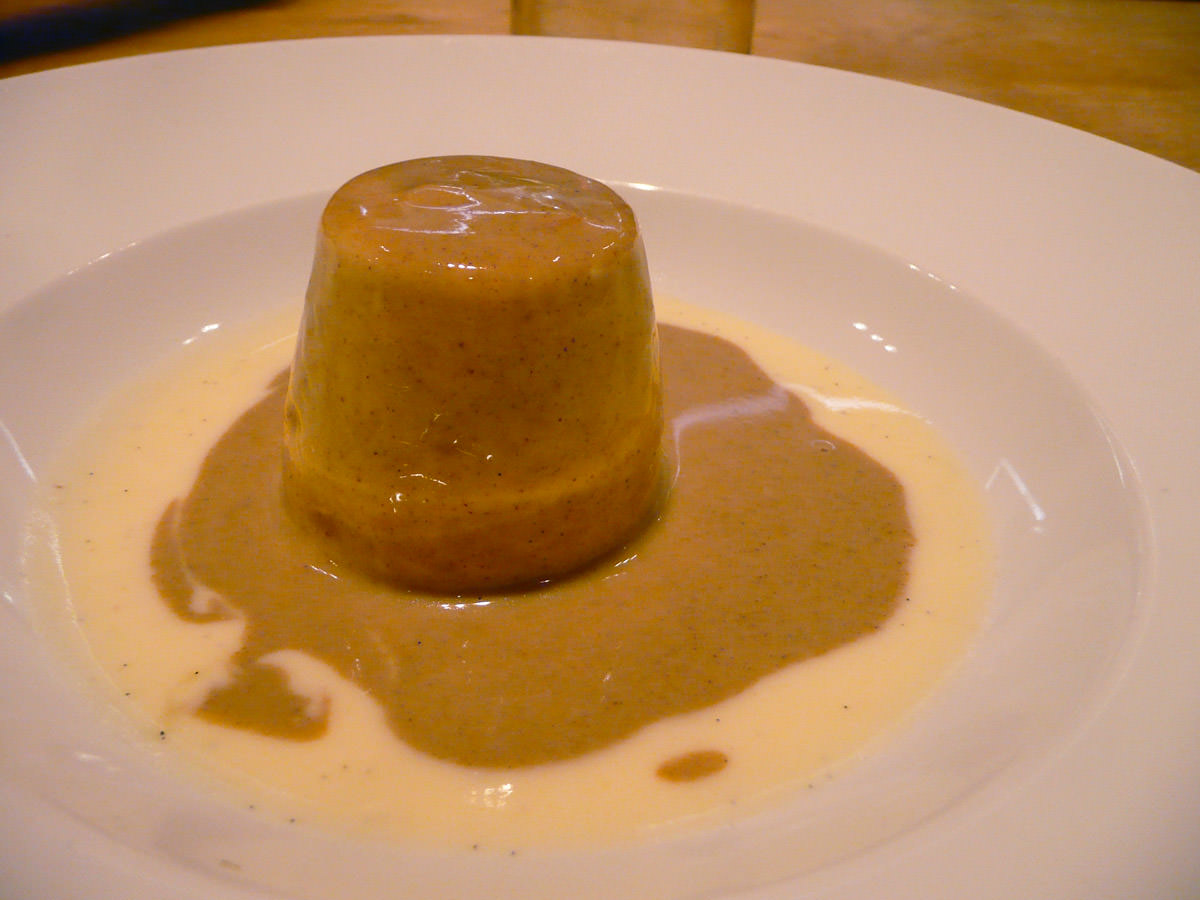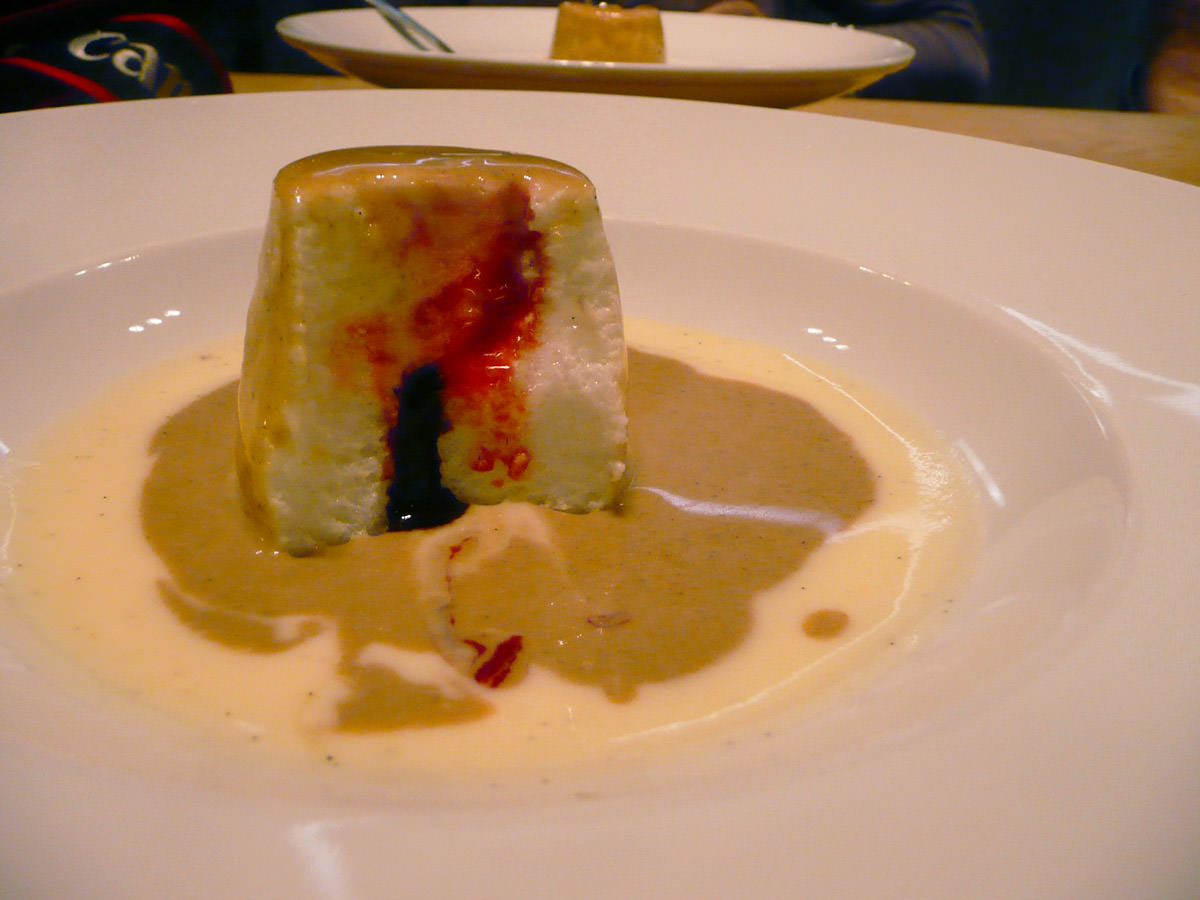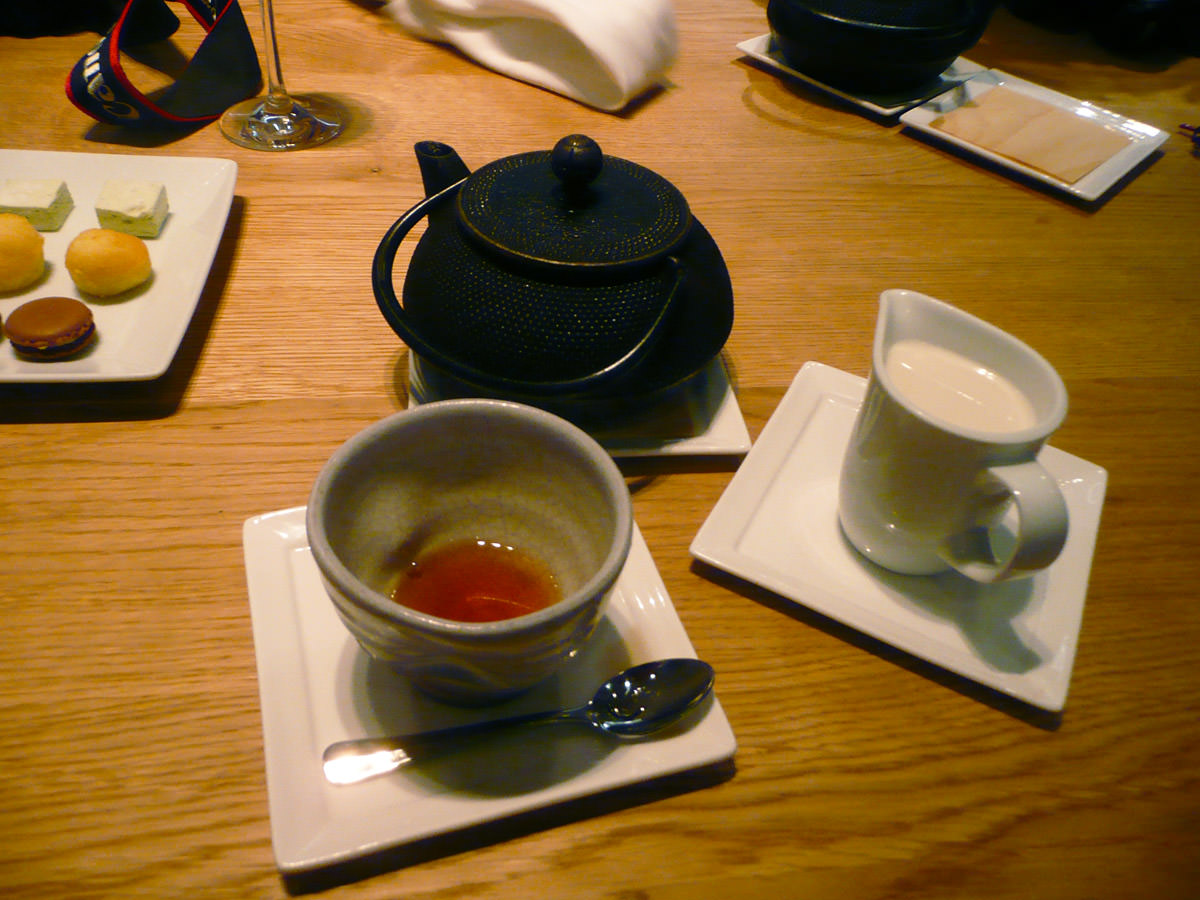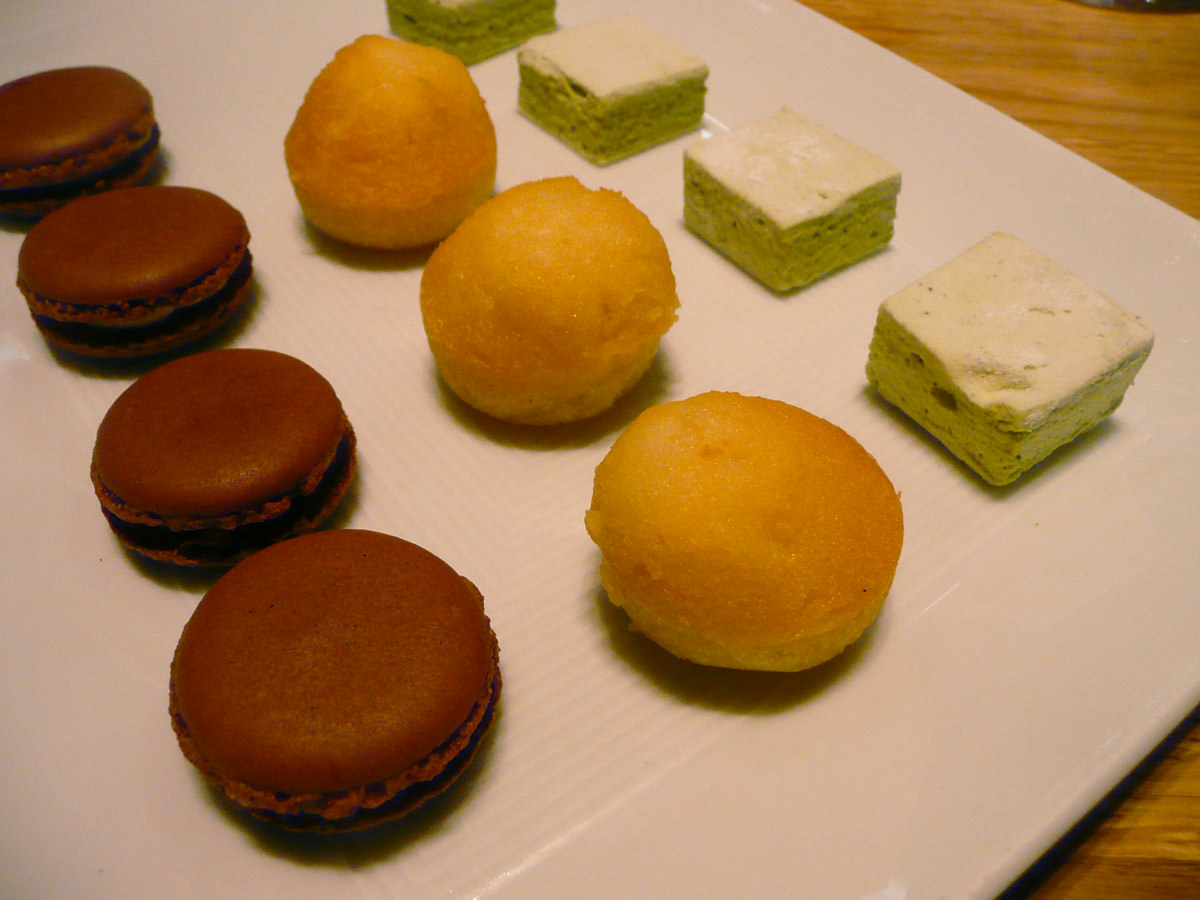Tetsuya’s, Sydney – and win a masterclass with chef Tetsuya Wakuda
I was lucky to be one of ten Australian food bloggers invited to attend an exclusive masterclass with chef Tetsuya Wakuda in his brand new master kitchen at his restaurant in Sydney. I’d never been to Tetsuya’s restaurant but had read about it at other food blogs and heard about it from friends. I’ve been told you need to make a weeknight reservation approximately 3 months in advance, and weekend reservations around 6 months in advance. So as you can imagine, I was absolutely stoked to be given this opportunity!
In this post:
- The masterclass with Tetsuya
- Degustation dinner
- Competition details – win a masterclass with chef Tetsuya Wakuda in Sydney
Masterclass
Tetsuya welcomed us to his new master kitchen. He seemed quite shy and confessed he was a little nervous, but once he started cooking and talking to us about his dishes, you could see he was totally in his element and having great fun.
The kitchen by Electrolux was stunning, like something you’d see in Lifestyles of the Rich and Famous (showing my age here!). There was a massive marble workbench fitted with two gleaming black touch-controlled induction cooktops. There were also two sinks sunken deep in opposite corners of the workbench, operated by knee pads instead of taps. The absence of the things you’d normally expect to see in a kitchen – taps, dials and burners – gave the kitchen a very sleek, almost futuristic look. To me, at first glance, it almost didn’t even look like a kitchen! There was a shiny black fridge built into wall of the kitchen – it blended in so well aesthetically that I didn’t even notice it was there until one of Tetsuya’s chefs opened it to retrieve ingredients. Although it looked beautiful, the kitchen was functional and practical. Tetsuya showed us how easy it is to clean the cooktops – you simply wipe them clean, no elbow grease required. We were told that this would be the very first time the kitchen would be used since being completed, and we were its very first audience.
Before he started cooking, Tetsuya told us there were no secrets in any the dishes he would be cooking for this masterclass – we should feel free to ask him anything we like. Being a vocal, curious and chatty bunch, we did just that!
First, a simple but classic dish: scrambled eggs. “I’m sure you all know how to cook scrambled eggs,” Tetsuya said, “But I’ll show you a few little things…” He told us that the best way to beat eggs is to lift the strands high in the air with a fork, rather than beating them within the bowl, which just creates bubbles. He added an ingredient that surprised most of the audience – creamed corn. He told us just a little creamed corn creates a lighter texture and helps prevent the scrambled eggs from getting rubbery – though I must admit as a lover of all things corn my first thought was to dump a whole lot more in there to make super corny scrambled eggs. He seasoned the eggs with white pepper and salt and added a generous amount of parmesan cheese, mixing well before pouring the mixture into the pan. Of course, there was also a generous amount of butter in the scrambled eggs – though Tetsuya told us generally speaking he doesn’t use much butter in his cooking. He cooked the scrambled eggs with a spatula and when they were almost ready, he added another ingredient I’m not used to seeing in scrambled eggs: ricotta cheese.
Throughout the masterclass, each dish that was cooked was whisked away when finished and quickly plated into individual serves for us all. The scrambled eggs were beautifully light and creamy. I’m definitely going to try the corn trick the next time I make scrambled eggs – I can’t believe I never thought of it before! I’m not so keen on the ricotta – in some ways I think the addition of the cheeses takes away some of the natural eggy flavour of the dish. I made a mental note to myself that when I do try the creamed corn trick I must be careful not to overdo it. Although I love corn, I also love the taste of eggs, so I’ll need to strike that delicate balance between corn, egg and of course, butter.
The next dish was scampi, which had been laid out on an oven tray. Tetsuya dressed the scampi with olive oil, grapeseed oil and freshly chopped herbs, then covered the tray with food wrap. He popped the tray into an oven, which he told us had been preheated at 100C, now turned down to 90C. Initially, everyone’s first thought was: won’t the food wrap melt? But we quickly realised that 90C is a very low temperature. I’m totally going to try cooking seafood this way!
When the scampi were ready, he seasoned them with salt and carefully arranged them, one by one, into a magnificent scampi mountain, then dressed them with more oil and herbs. Watching him work and smelling the oil and herbs made my mouth water.
When I received my individual serve, I ignored the fork and lifted the meat off the tail shell with my fingers. The scampi meat was sweet, moist and ever so delicate. I don’t think I’ve eaten scampi before, it was delicious!
The next dish also used the food wrap technique – this time, fresh snapper fillets, cooked in oil, seasoned simply with salt and pepper. The fish fillets were placed in the oven to cook skin side-up, which Tetsuya told us protects the flesh from drying out.
You could tell Tetsuya was having fun! We all laughed and cracked jokes throughout the masterclass. As he prepared the next dish, a warm salad of scallops, he grinned as he worked, making me smile too. He placed wakame (seaweed) in the centre of a dish of thinly sliced scallops, then arranged a ring of micro greens and herbs on top.
He mixed soy sauce, mirin and brown sugar with finely chopped salted black beans and spooned this over the scallops. He scattered finely chopped orange zest over the greens, the orange bits looking like tiny flowers. And then right on the top, he arranged a handful of fine tendrils of roasted chilli. He then heated up sesame oil in a pan and then poured it over the dish, flash-cooking the scallops with a sizzle and crackle.
I love scallops, and this was one of my favourite dishes of the class. Tetsuya instructed the staff member plating up the serves: “Make sure you put plenty of the sauce on the plates!” The hot oil only just cooked the scallops – they were tender and sweet, flavoured by the delicious combination of sesame oil, black bean, orange zest and chilli. Tetsuya told us that orange zest goes very well with seafood, especially scallops and king fish, and you don’t need to do anything special to the orange zest, just use it!
Next, he steamed Alaskan crab legs. He told us you can make your own steamer by placing a metal cake tin upside down in a pan over a few mugs that are the same height. He arranged the crab legs on a bed of bamboo leaves – someone asked about the flavour imparted by the bamboo – he confessed in that this case he was using the leaves more for aesthetics than flavour. I’m not a big fan of crab, but was quite excited thinking that I was about to eat a “Deadliest Catch” crab (have any of you seen that TV show?)
Tetsuya did not add anything to the crab legs so we could appreciate its natural flavour. The meat was soft and sweet, more delicate in texture than I had ever imagined the meat from one of those rather menacing looking Alaskan king crabs would be.
The last dish Tetsuya demonstrated was chicken tagine, which he told us he would cook without using a tagine. He told us it’s a great party dish – easy to prepare and takes about 30 minutes. We all commented on how fantastic the onions, garlic, carrots and celery smelled as they fried in the pan. Tetsuya grinned at our enthusiasm and said happily, “It’s so nice to cook for people who enjoy their food.” And as more photos were taken around him, he asked, “So what is it you all do again?” We all laughed at this and explained that we’re food bloggers – we all have websites, food blogs. We love food, and we love to eat. We visit restaurants and write about them. Some of us cook, some of us write recipes. We all love to write and talk about food at our blogs. Tetsuya smiled at this and said he’s not so good with computers.
To the vegetables he added chicken, tomato puree, preserved lemon, olives, dates and anchovies. It smelled wonderful. I felt like I’d been eating for hours already but I couldn’t wait to try this! The chicken thigh fillets had been marinating in Herbie’s Spices tagine mix, and he now added more spoonfuls of the spice mix straight into the pan. He recommended tinned tomatoes over bottled passata, as he reckons tinned tomatoes have better flavour. He also told us if no anchovies are available, fish sauce can be used as a substitute.
In addition to Herbie’s tagine mix, he also added ground long pepper, which most of us had not heard of. Its aroma is reminiscent of star anise and cassia bark. Tetsuya asked one of his chefs to show us what long pepper looks like, and a little dish of the spice was passed around – we peered at it, inhaled its aroma, and of course, photographed it.
To go with the chicken, Tetsuya prepared some cous cous, simply adding hot water. A few of us asked: “What about chicken stock?” Tetsuya assured us that hot water was all that was needed, as the chicken dish would have plenty of flavour. He stirred raisins and shallots through the cous cous. It looked very good.
Before serving up the dish, Tetsuya tasted it and then added more spoonfuls of the ground long pepper and tagine spice mix. He passed on another useful tip: it is always better to under-season your stew or casserole and then adjust the seasoning at the end. Once it’s been over-seasoned, you can’t “take it back”.
The tagine-less chicken tagine was absolutely delicious. It was savoury and spicy yet sweet, with the interesting flavours and textures of the olives, preserved lemon and dates adding saltiness, tang and chewiness. Cliched phrases popped into my head as I ate – it was “an explosion of flavour” and there was definitely “a party in my mouth”! The gravy was rich and plate-licking good (no, I didn’t, though I was tempted!) and the fluffy cous cous soaked it up beautifully. The chicken thighs were succulent and I wanted more, MORE! It was a hearty, comforting dish and tasted like it had been stewing away for hours. I’d have loved to have gone back for seconds, but I knew there was still a degustation dinner to come and I had to be sensible!
And so the masterclass came to an end. Tetsuya had been wonderfully patient with our photo-taking throughout the class and now he good-naturedly posed for photographs with all of us (a group shot and individual shots with each food blogger – I now have a photo I will refer to as “Tets and me” :D).
We’d known about it all along, but somehow it seemed unbelievable that we would now sit down for a ten-course degustation dinner! It was truly an epic night of dining (and accordingly, this has turned out to be an epic post)!
Degustation dinner
And so we took our places at a long table in a room next door. At each place setting was a fresh bread roll, just waiting to be broken into two and spread liberally with butter – and not just any butter, but Tetsuya’s oh-so decadent butter: unsalted butter blended with truffles, parmesan and ricotta. My brain warned: “Don’t fill up on bread!” but I ignored it, confident in my appetite (and the eating pants I kept referring to on Twitter!). I ate the whole bread roll, indulgently slathered with lashings of that special butter.
The first course was chilled Japanese pumpkin soup, thick yet velvety smooth, with a dollop of white miso cream. It was sweet and refreshing and easily the most delicious pumpkin soup I have ever eaten, by light-years! I’m not usually a fan of pumpkin soup, but if they all tasted like that, I’d have it every day! This ended up being my favourite dish of the entire degustation dinner.
Next, sashimi of kingfish with black bean and orange. Regular readers will know I am not a fan of raw fish. But before going to this special dinner, I’d made a solemn vow: “I will try everything that is placed before me”. And I was surprised and pleased as I did enjoy this dish – the flavours of black bean, orange zest and sesame were so good I didn’t mind the texture of the raw fish as much as I normally do. The fine threads of roasted chilli and the micro greens added subtle texture and flavour to the dish. I ate it all and wished I could lift the dish to my lips and drink the rest of the oil and juices down. Orange with scallops, orange with kingfish, I’m your newest disciple!
Having tasted the scampi during the masterclass and fallen utterly head over heels in love with it, I was thrilled when the next course was served: soft roast scampi tails with herb and citrus oil. The New Zealand scampi was draped over witlof that had been confit cooked in orange and then charred. The oil had been infused with the flavours of lemon, lime and tarragon – it was a citrus lover’s dream dish, sweet and tangy, balanced beautifully with the slightly bitter flavour of the witlof.
Next: Tetsuya’s signature dish – salad of confit ocean trout with zucchini and non-pasteurised roe. The trout had been cooked in oil at a very low temperature and was soft and smooth, with a jelly-like texture that was almost not like fish at all, topped with finely diced roasted zucchini and eggplant and served on a circular bed of ocean trout roe on a thin layer of goat’s cheese, garnished with drizzles of parsley oil. I think I’m just not a fan of the soft texture of confit fish; while I appreciated the quality and the flavours of this dish, it was not one of my favourites of the evening. But it’s just my personal taste (nothing wrong with the dish!).
I wasn’t so fond of the next dish either – again, a matter of personal taste – raviolo of octopus with oregano and black olives. The oregano, black olives and, diced tomato and basil leaves gave this dish an Italian touch, with the surprise of sushi rice in the raviolo filling, as well as chunks of octopus. The basil was fresh and fragrant and the cubes of tomato were sweet and juicy. This was the only dish of the night I did not finish because I really dislike octopus – obviously, I dislike octopus more than raw or confit fish, because I finished both the kingfish and trout dishes.
The sixth course was breast of chicken with corn and foie gras. I couldn’t believe how moist and juicy this poached breast of baby chicken was – almost as succulent as a piece of chicken thigh! Hidden in the bed of creamed corn mash was a small portion of foie gras. I chuckled to myself as I thought of the hidden foie gras as “ninja foie gras”. I really enjoyed the simplicity and fresh flavour of the delicately poached juicy chicken with the corn; I thought the richness added by the foie gras was quite unnecessary.
I don’t usually eat very rare beef, but I was surprised how much I enjoyed the sirloin of wagyu with braised leeks, sansho and soy. The waiter informed us that the thin slices of beef had been cooked shabu-shabu style. They were so soft they practically melted in my mouth. The chunky-cut caramelised braised baby leeks were sweet and fun to eat – I love separating the layers of leek and eating them one by one (I eat whole roasted onions in a similar way, I press them with my fork to separate the layers/rings and then eat them one by one). This was the final savoury course.
This was my favourite of the desserts: pione grape sorbet with sauternes jelly. It was cool and refreshing and a perfect palate cleanser following the savoury courses. In the bottom of our cocktail glasses were three perfectly peeled grapes. The grape skins were used to make the sorbet and the delicious grape “soup”. I loved this and wished we’d been served great big bowls of it instead of cocktail glasses!
The second dessert course was cannellini beans with marscapone and soy caramel. Cooked beans are often featured in Asian desserts – beans in ice kacang, bean soups served hot or cold, and so on – so I am no stranger to desserts featuring beans! Having said this, I would’ve been perfectly content if the dessert had not featured any beans. The marscapone mousse was light and creamy. The soy caramel, our waiter informed us, is made by adding soy sauce to caramel. The marscapone sat in a pool of blue cheese anglaise, which added even more richness to the dish.
The last dessert was the floating island with a double anglaise of vanilla bean and praline. The floating island is a soft and fluffy meringue, airy and light, served “floating” on the anglaise. One of the waiters told us the secret to getting rid of the “eggy” smell in the meringue – finely ground fresh rosemary, whipped into the egg whites.
Sinking my spoon into the soft, yielding meringue was such a pleasure, then tasting the meringue as it melted on my tongue and greedily drinking down my first spoonful of vanilla bean and praline anglaise – I was in heaven! The first mouthful of meringue had revealed a white interior to the island, but with my next mouthfuls, not one, but two surprises – an ooze of raspberry and another of dark chocolate which, once released, flowed freely into the anglaise to make a pretty and appealing swirl of colours. I don’t mind telling you I would’ve lifted the dish to my mouth and drunk the double anglaise down if I could. Instead, I had to be content scraping the dish with my spoon (as quietly as possible!) and subtly tilting the dish to get every drop of anglaise possible into my spoon.
To conclude this spectacular meal: coffee or tea, served with petit fours. My English breakfast tea was served in a Japanese teapot with a lovely handmade cup which had perfectly positioned indentations for my thumb and forefinger, so much more comfortable and pleasurable to pick up and hold than a standard cup with a handle.
The petit fours were: green tea marshmallows, coffee and date friands and chocolate macarons with lemon curd and pink peppercorn filling. The sticky gooey square of marshmallow had a slightly bitter flavour. The coffee and date friands were a perfect, moist mouthful. The chocolate macarons were my favourite, with a tangy lemon curd filling with surprise specks of pink peppercorn adding a burst of unexpected heat. There’s something about eating little sweet things that is so enjoyable and delightful!
Tetsuya’s
529 Kent St, Sydney
Telephone: +61 2 9267 2900
This was truly a once-in-a-lifetime event and I feel so lucky and grateful to have been a part of it. Tetsuya’s restaurant was as amazing as I thought it would be, the staff were knowledgeable, friendly and efficient, and Tetsuya is not only a brilliant chef, he’s a really nice guy too. It was great meeting other food bloggers, though I did feel like the the poor old country bumpkin cousin all the way from the West! I felt very awkward initially when it was obvious most of the others knew each other, though everyone was very friendly :) And when everyone took their cameras out, I felt extremely self-conscious as I had the only point-and-shoot camera, dwarfed and looking so pathetic surrounded by everyone else’s digital SLR cameras. Still, I had fun, got to eat some amazing food and learned interesting and useful tidbits. What I loved about the degustation dinner was that everyone got individual serves of the dishes, so we could take as many photos as we wished of our own meals without worrying about making anyone else wait to eat! And it’s also fantastic to be in the company of people who don’t think it’s strange when you whip out your camera to photograph the food (in fact, they’re right next to you, already taking photos themselves!).
See the list of posts from my Sydney trip.
So, here are the details of the competition:
Win a masterclass with Tetsuya Wakuda
UPDATE 14 May 2010
The winner has been announced, congratulations!
Electrolux is giving readers of The Food Pornographer the chance to win a ticket to an exclusive masterclass with Tetsuya. Just fill in the entry form at The Food Pornographer’s competition page to win.
This competition is open to Australian residents aged 18 and over. The 12 best entries received will each win:
- A single invitation to an exclusive Tetsuya Masterclass at Tetsuya’s restaurant, 529 Kent St, Sydney NSW on the evening of Tuesday 24 August 2010 from 6pm
- Return economy airfare from the winner’s nearest Australian capital city
- One night’s accommodation on the night of the Masterclass
- Transportation by private car from the winner’s accommodation within the Sydney metro area (50km radius from Sydney city centre – GPO) to Tetsuya’s restaurant for the Masterclass and then back to their accommodation within the Sydney Metro area stipulated above.
All entries must be received by 12 midnight AEST Tuesday 4th May 2010.
Read Terms and Conditions
Enter Tetsuya Masterclass Competition NOW!
